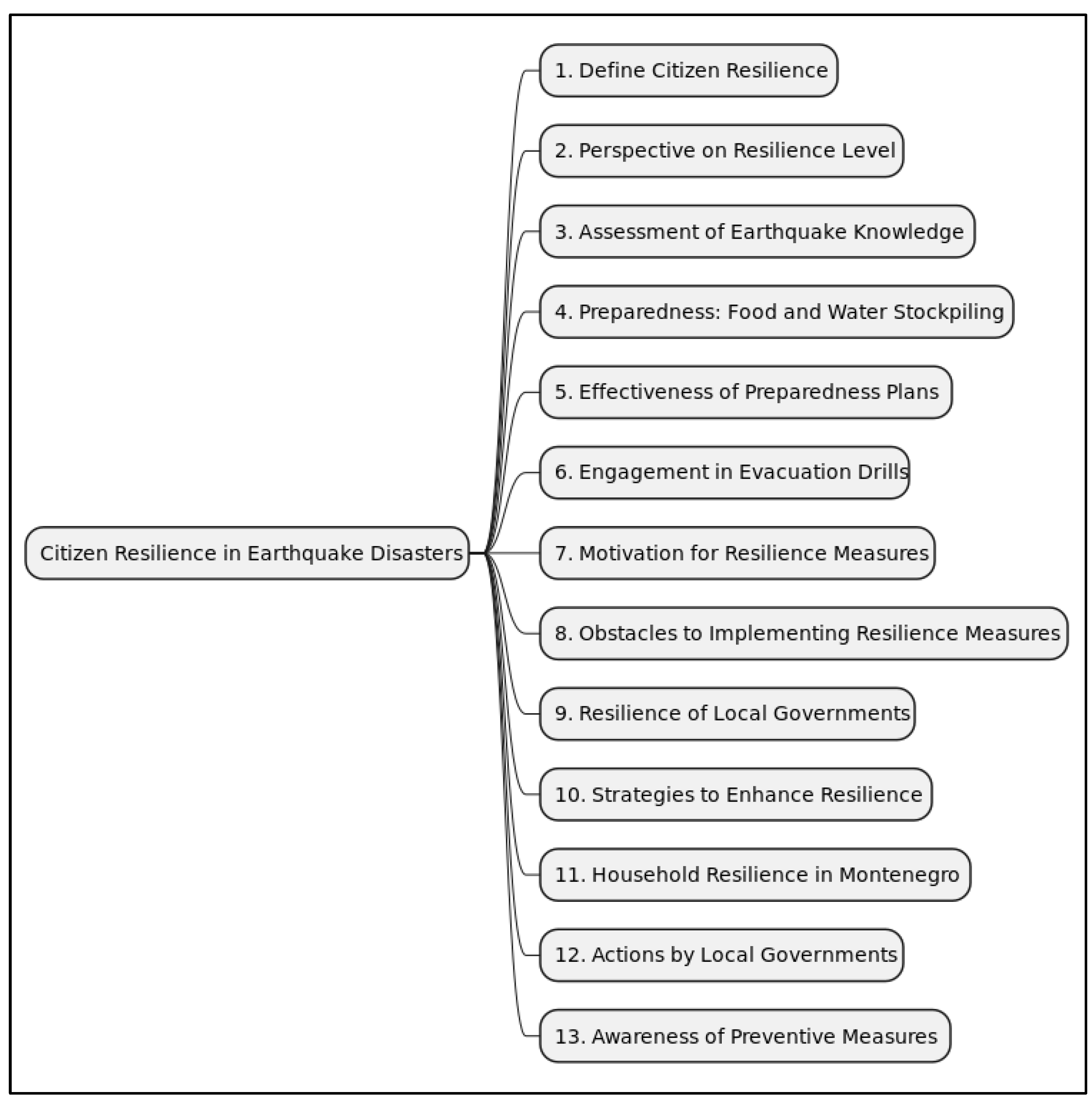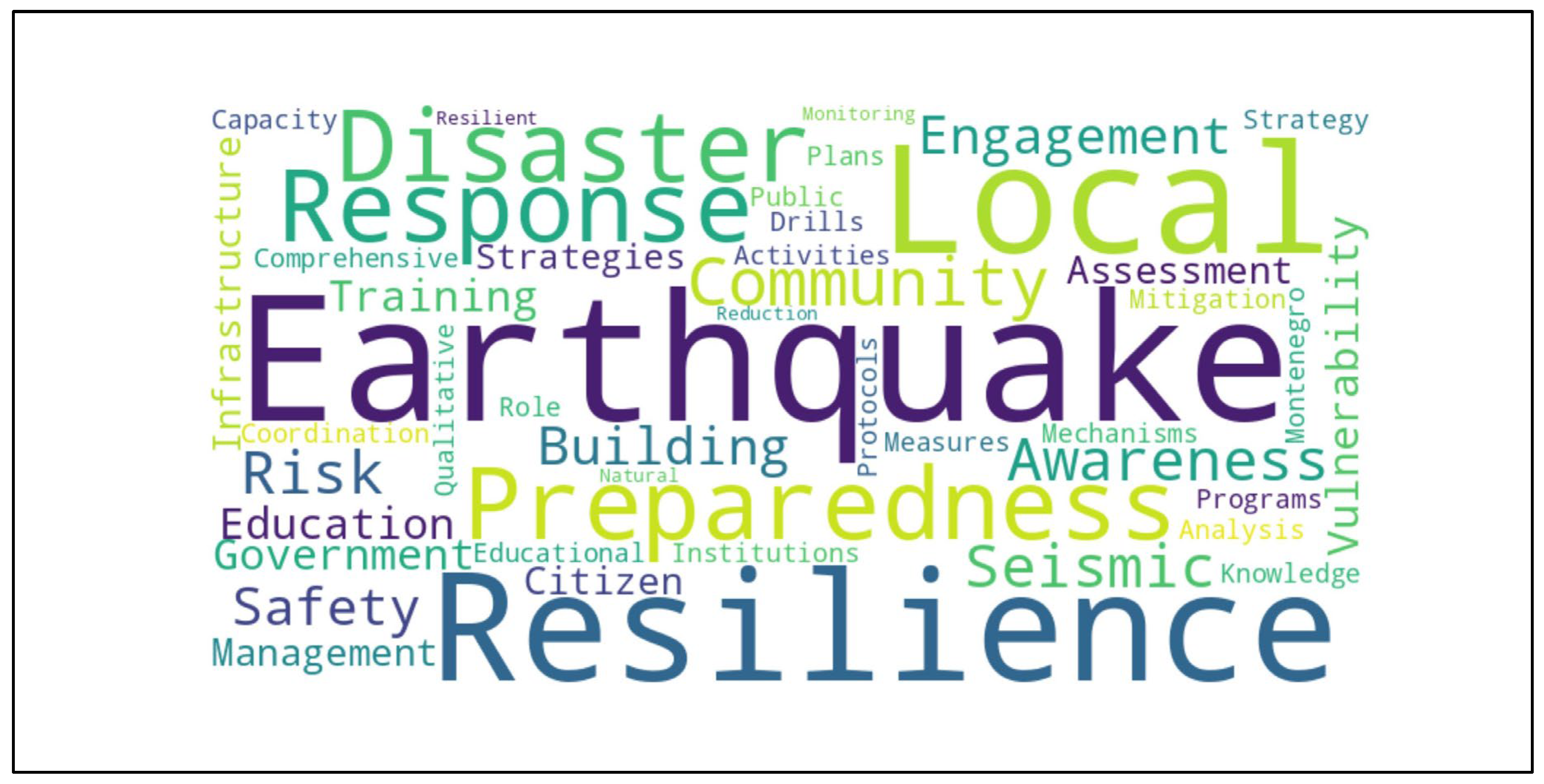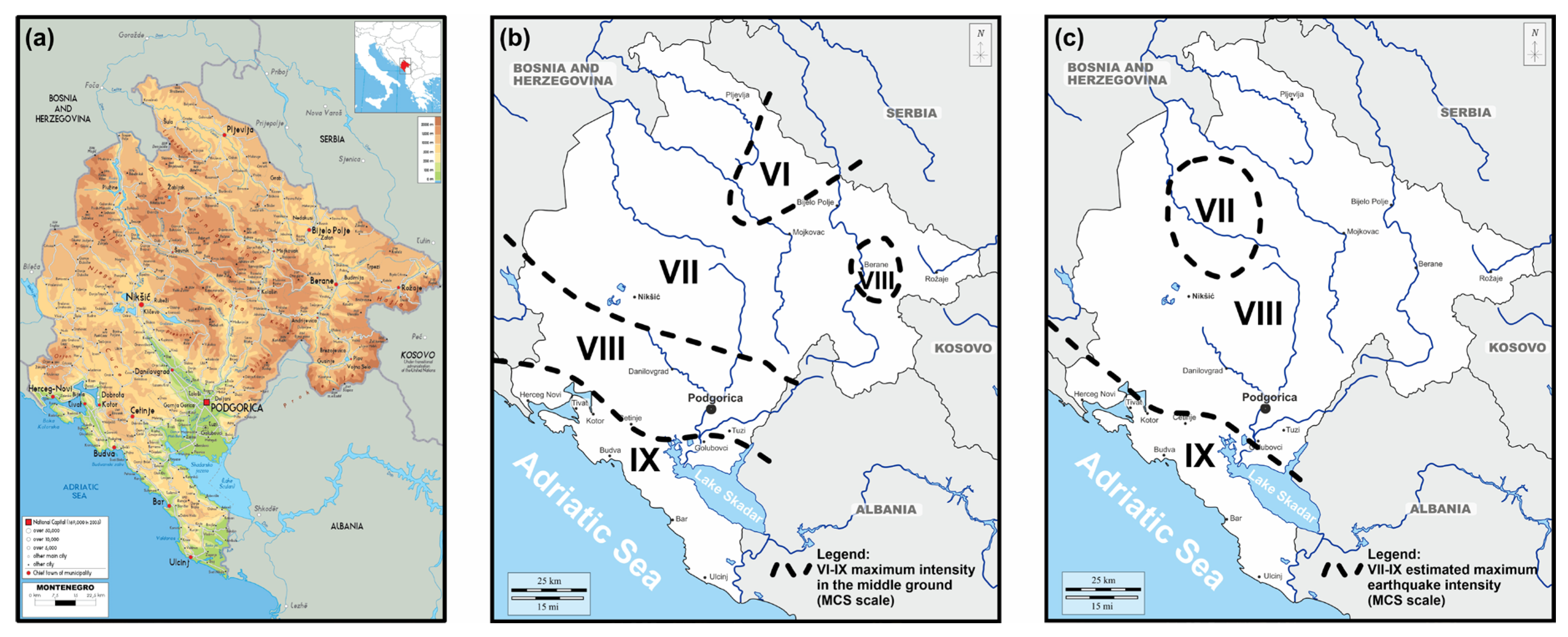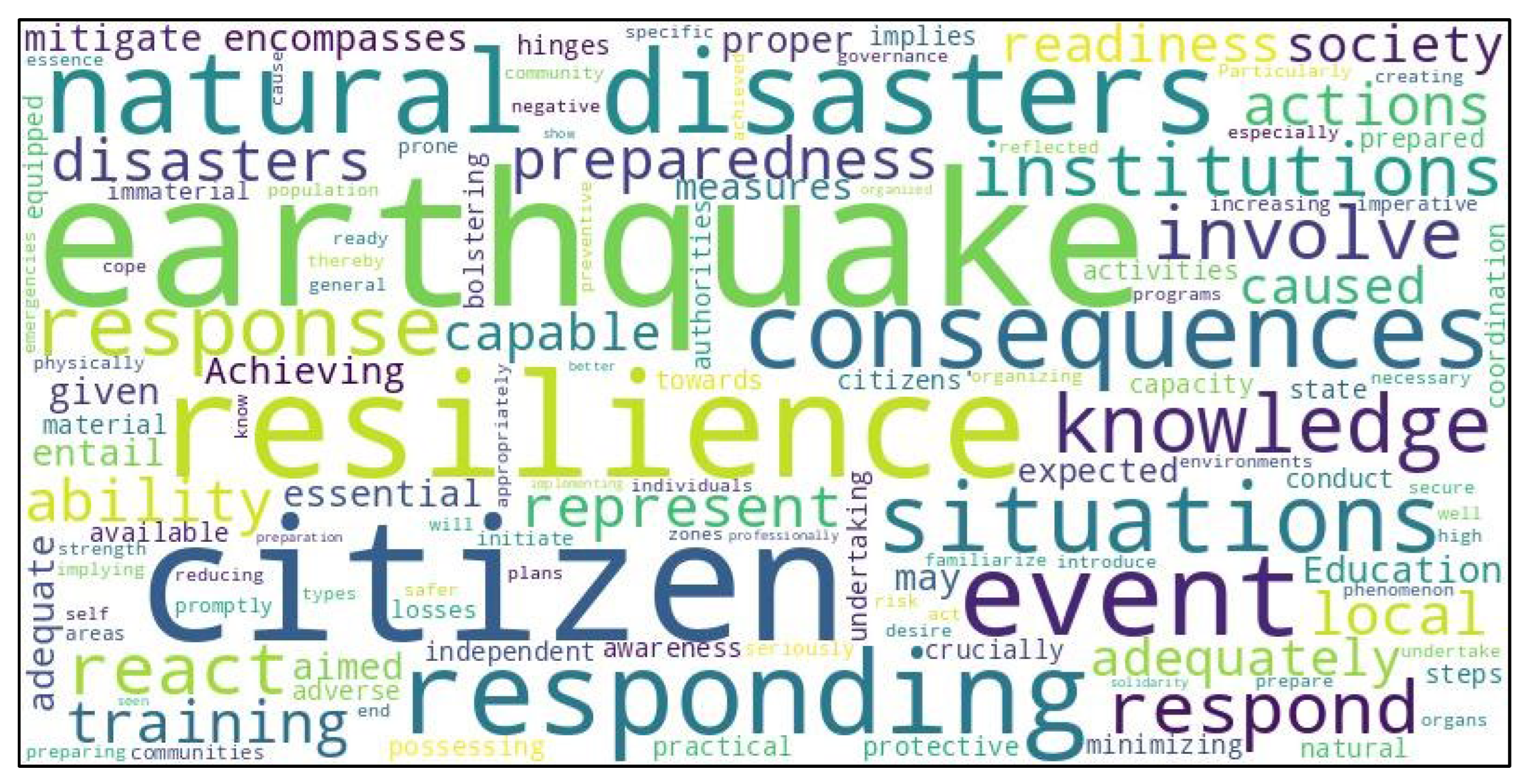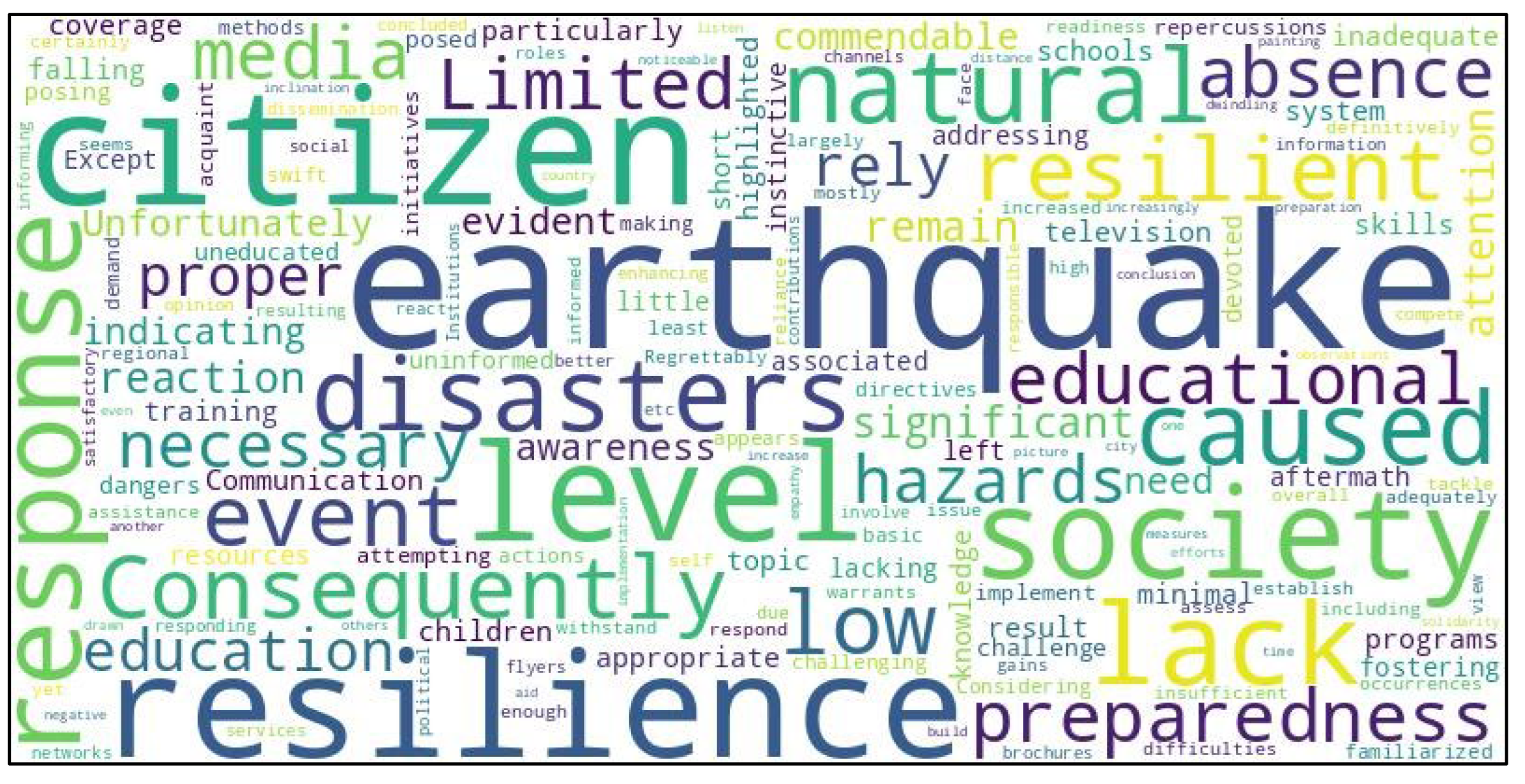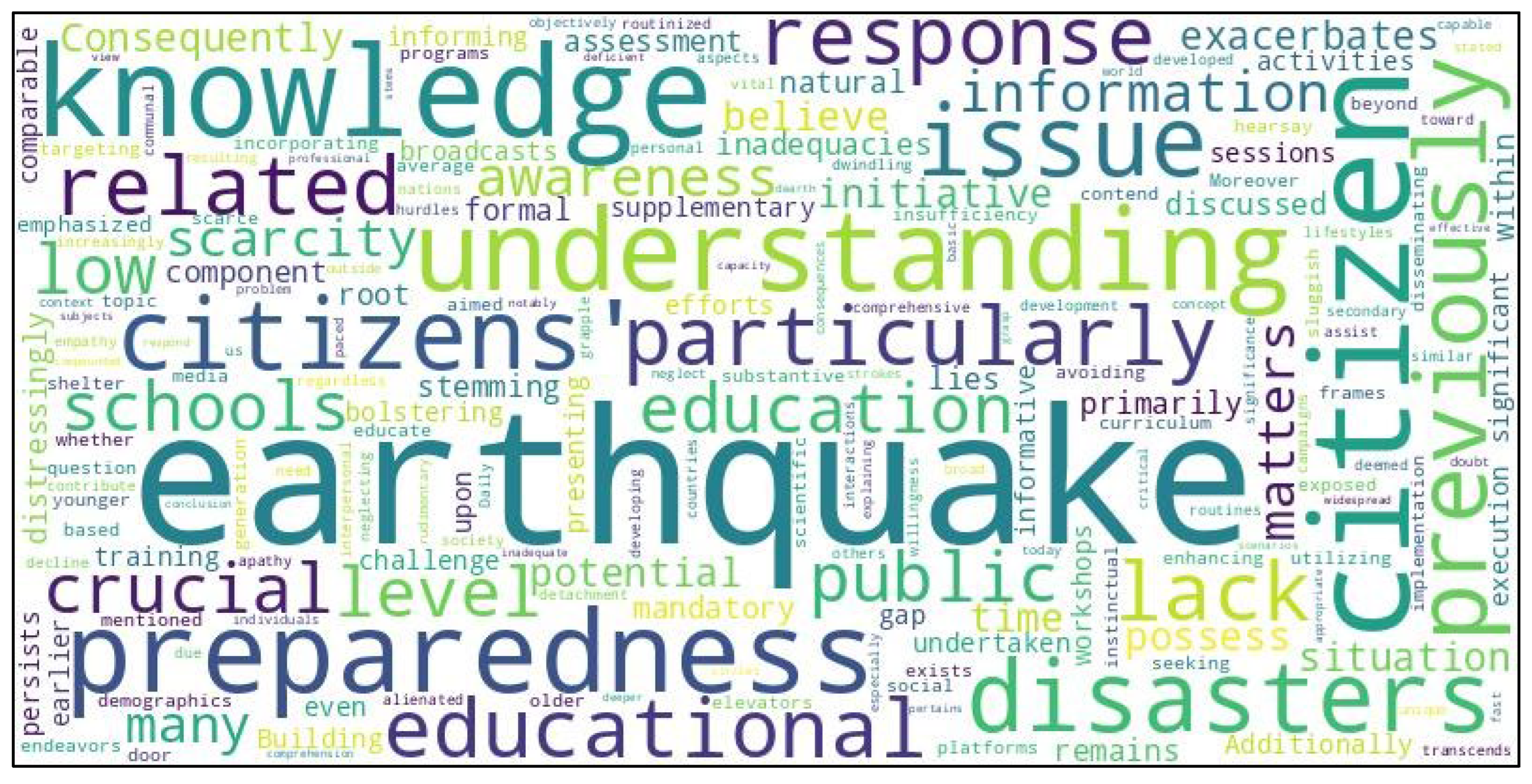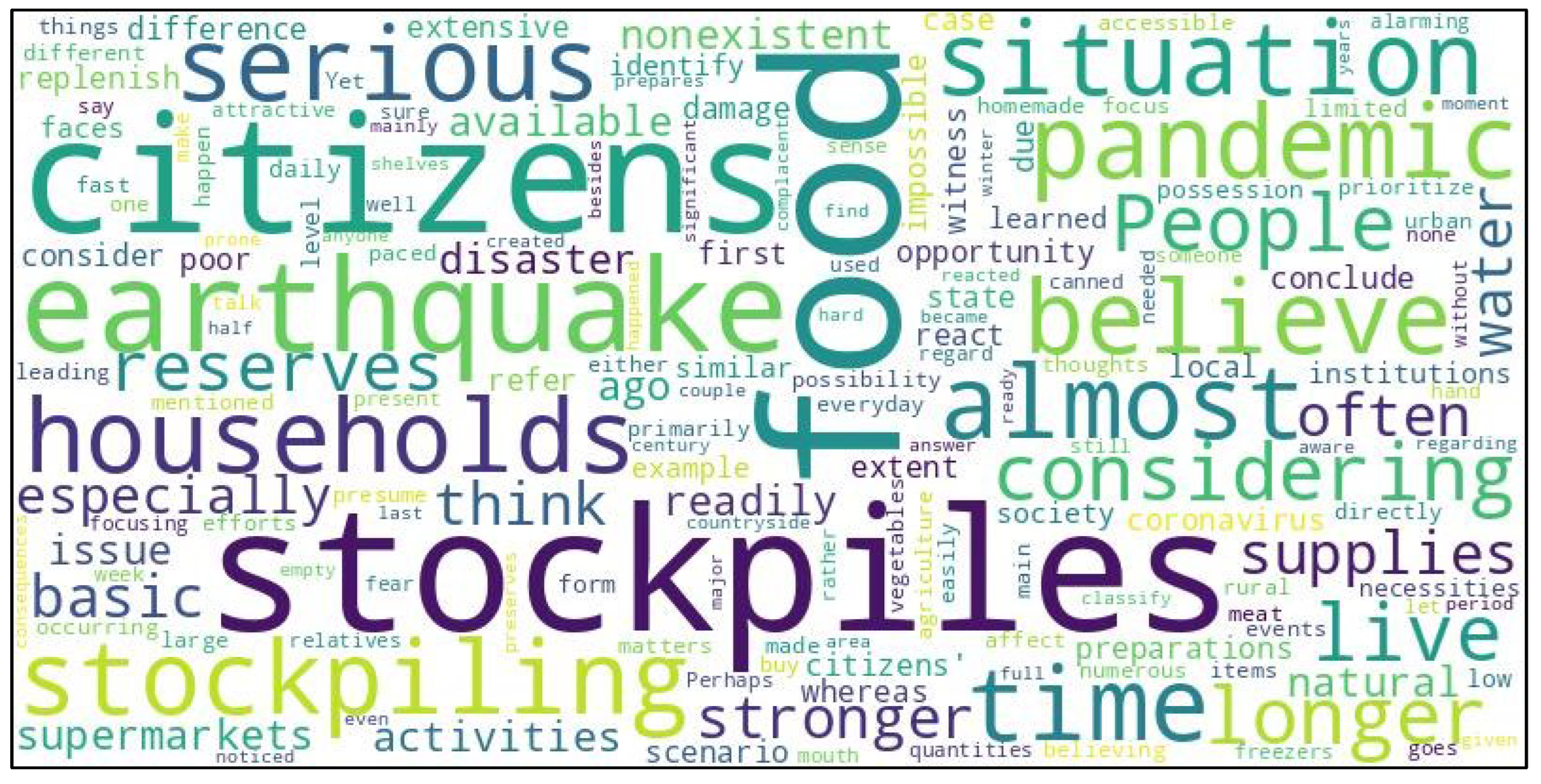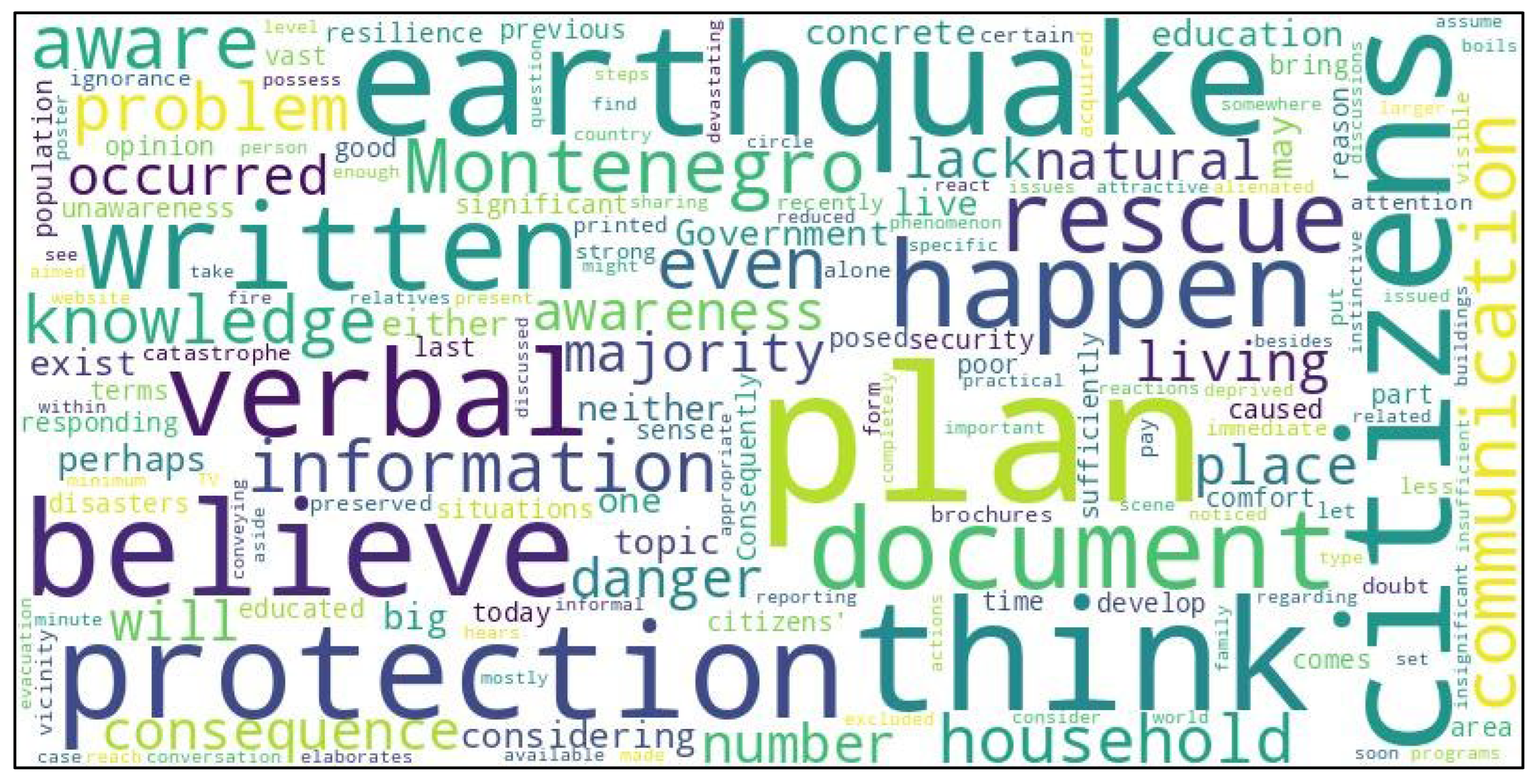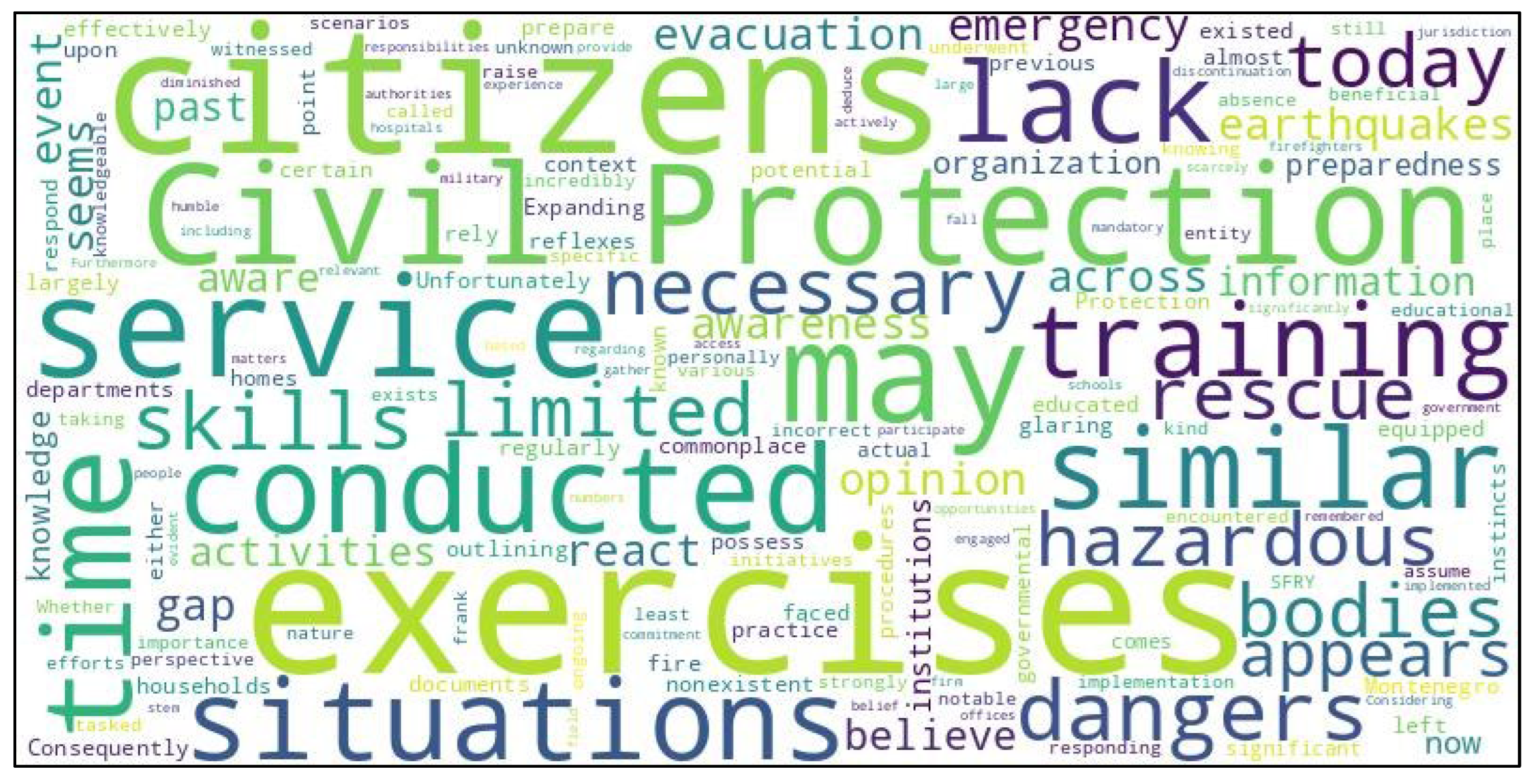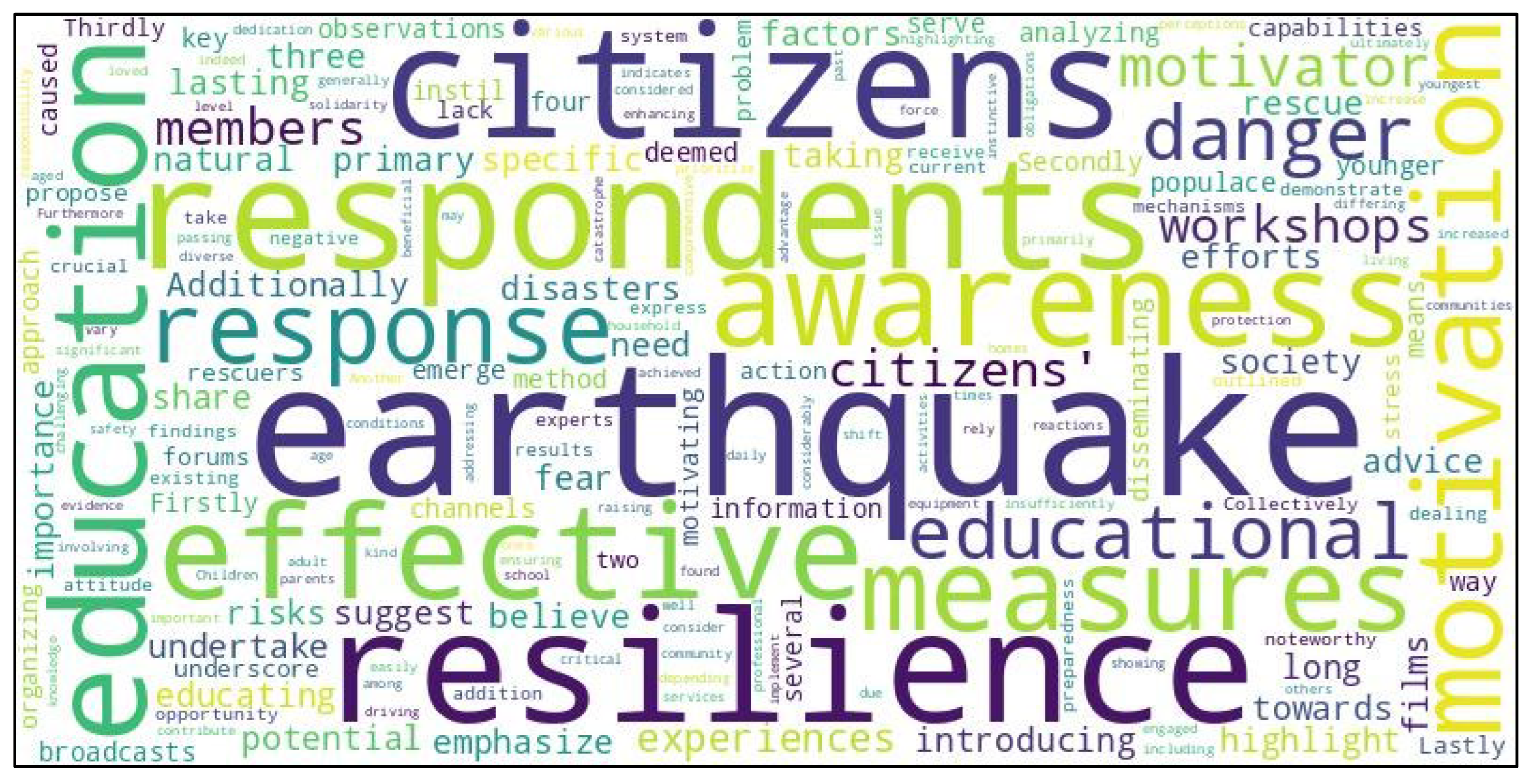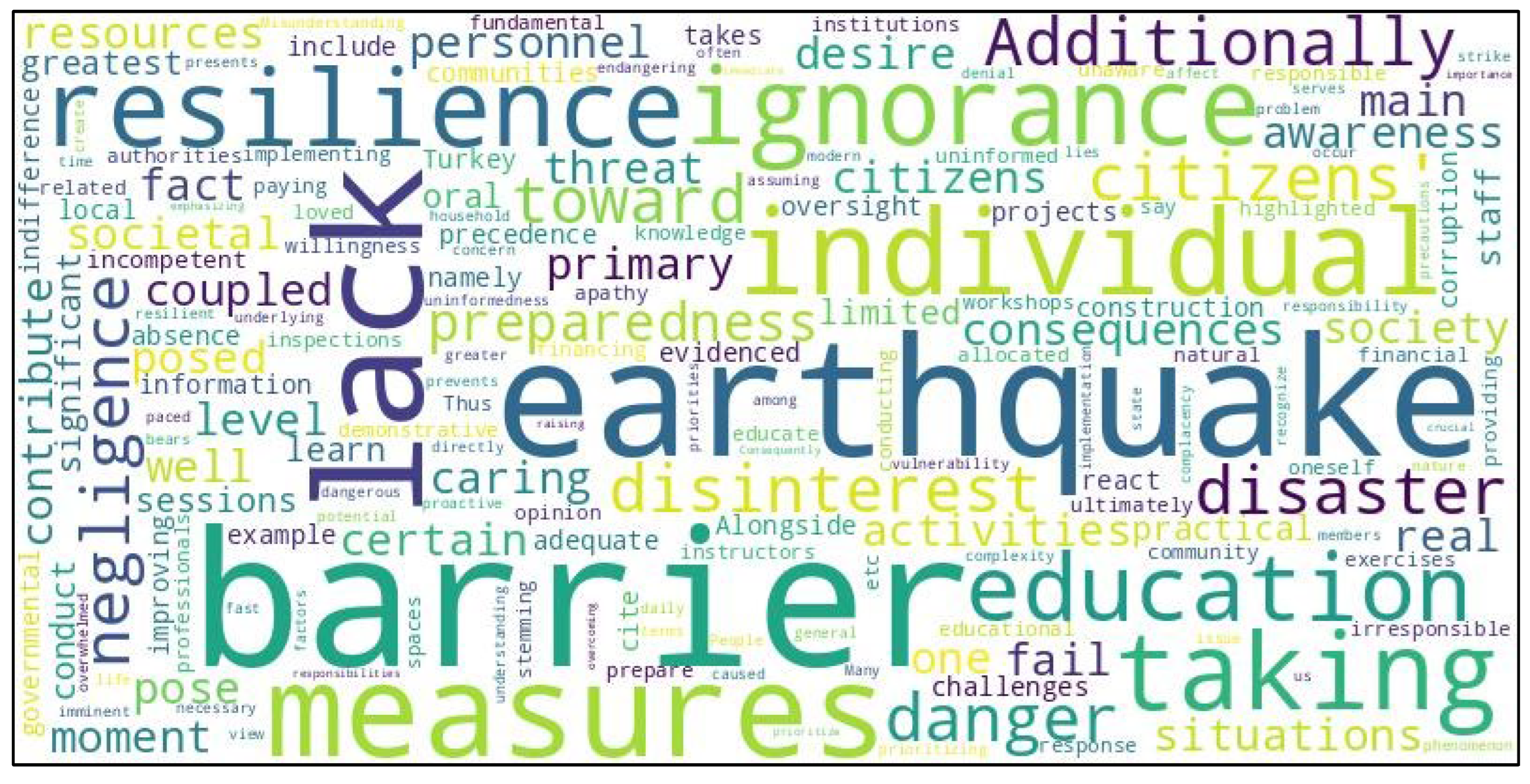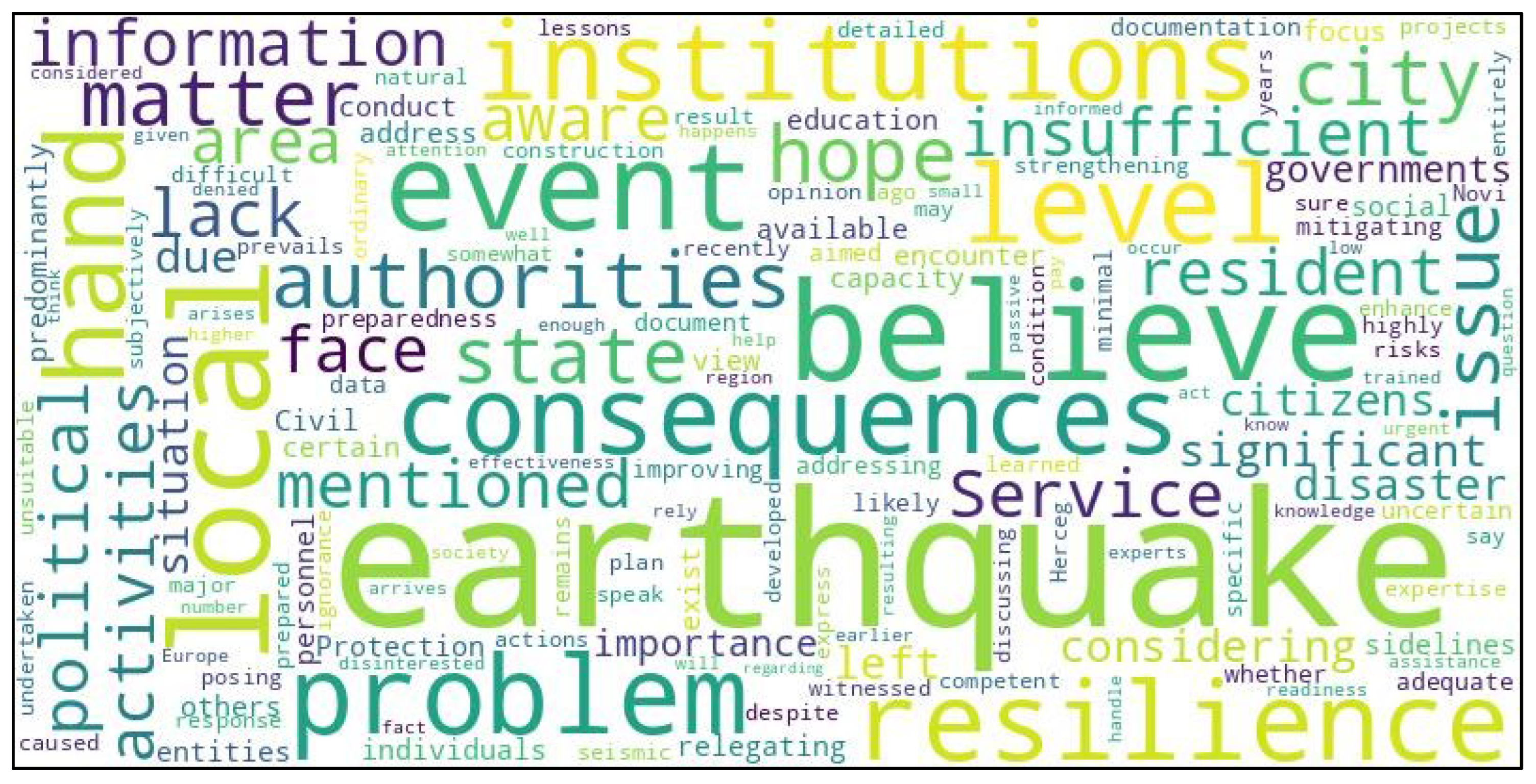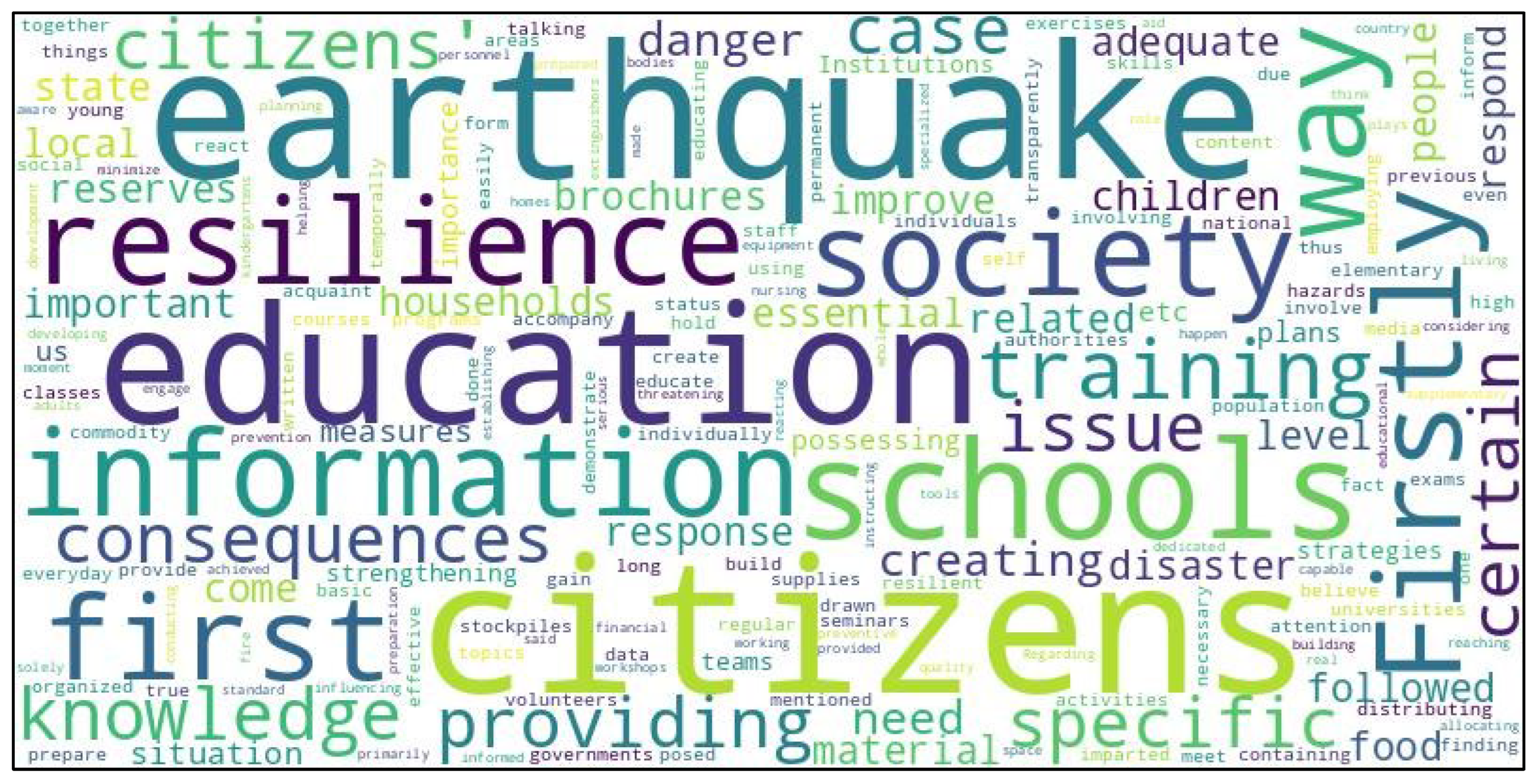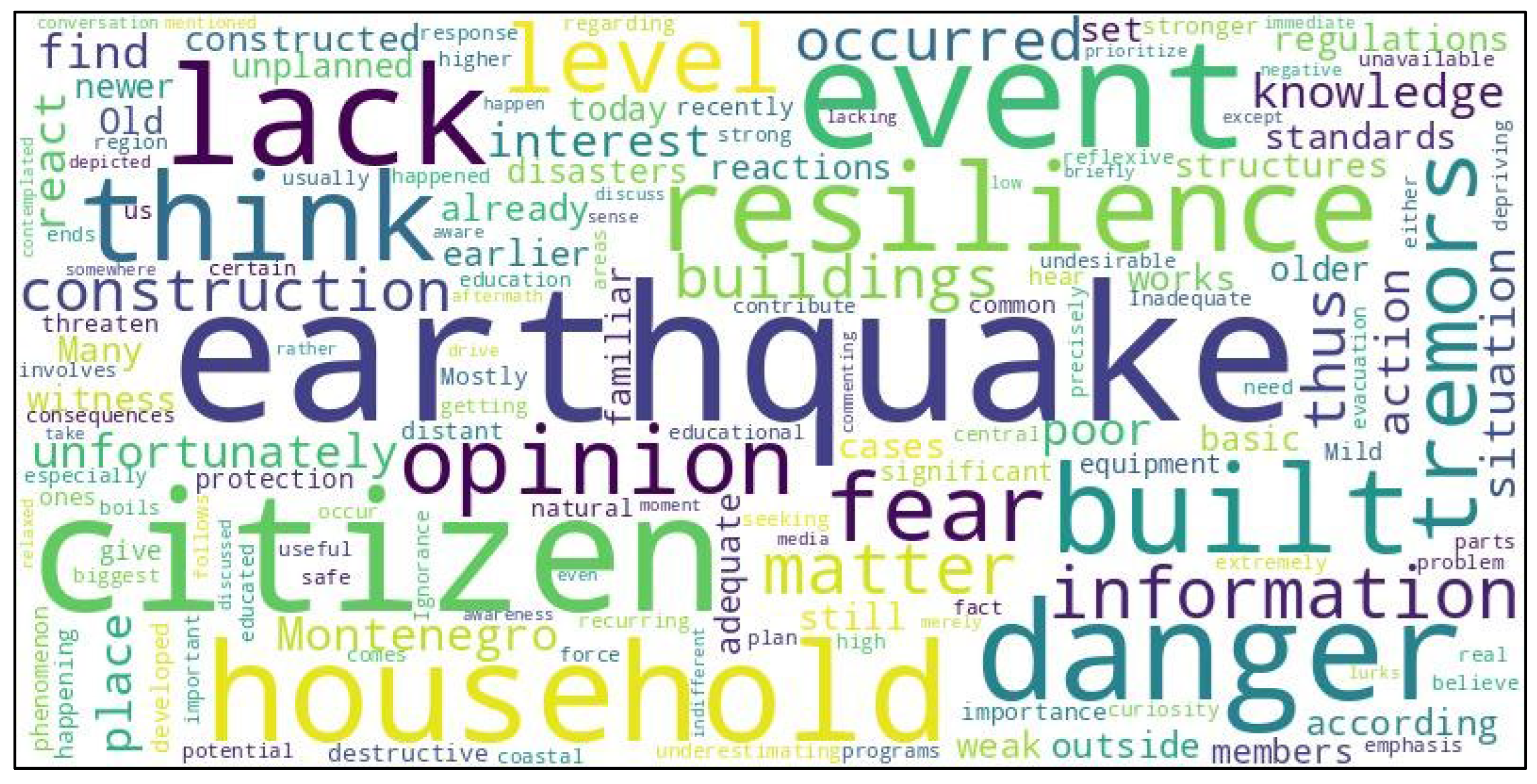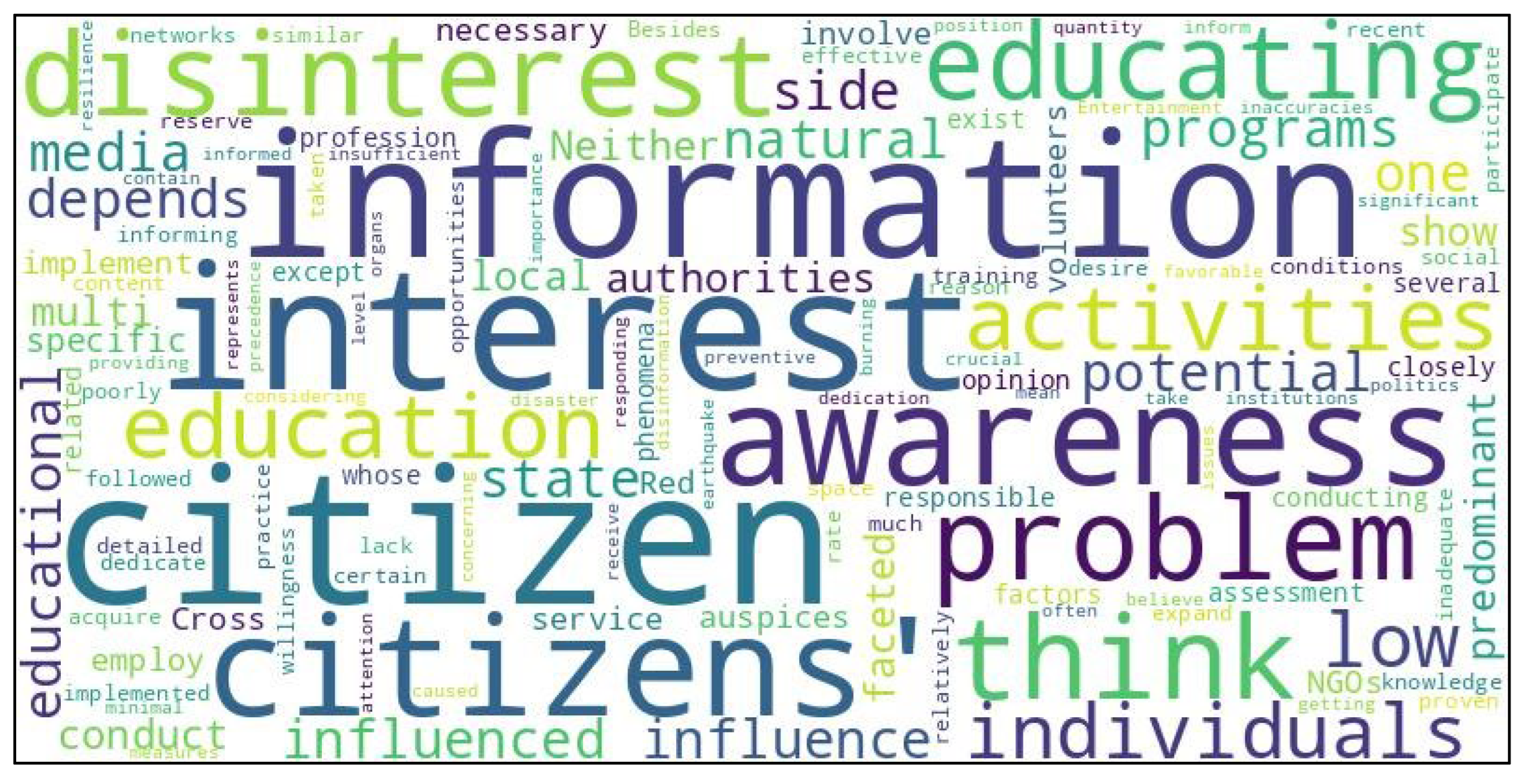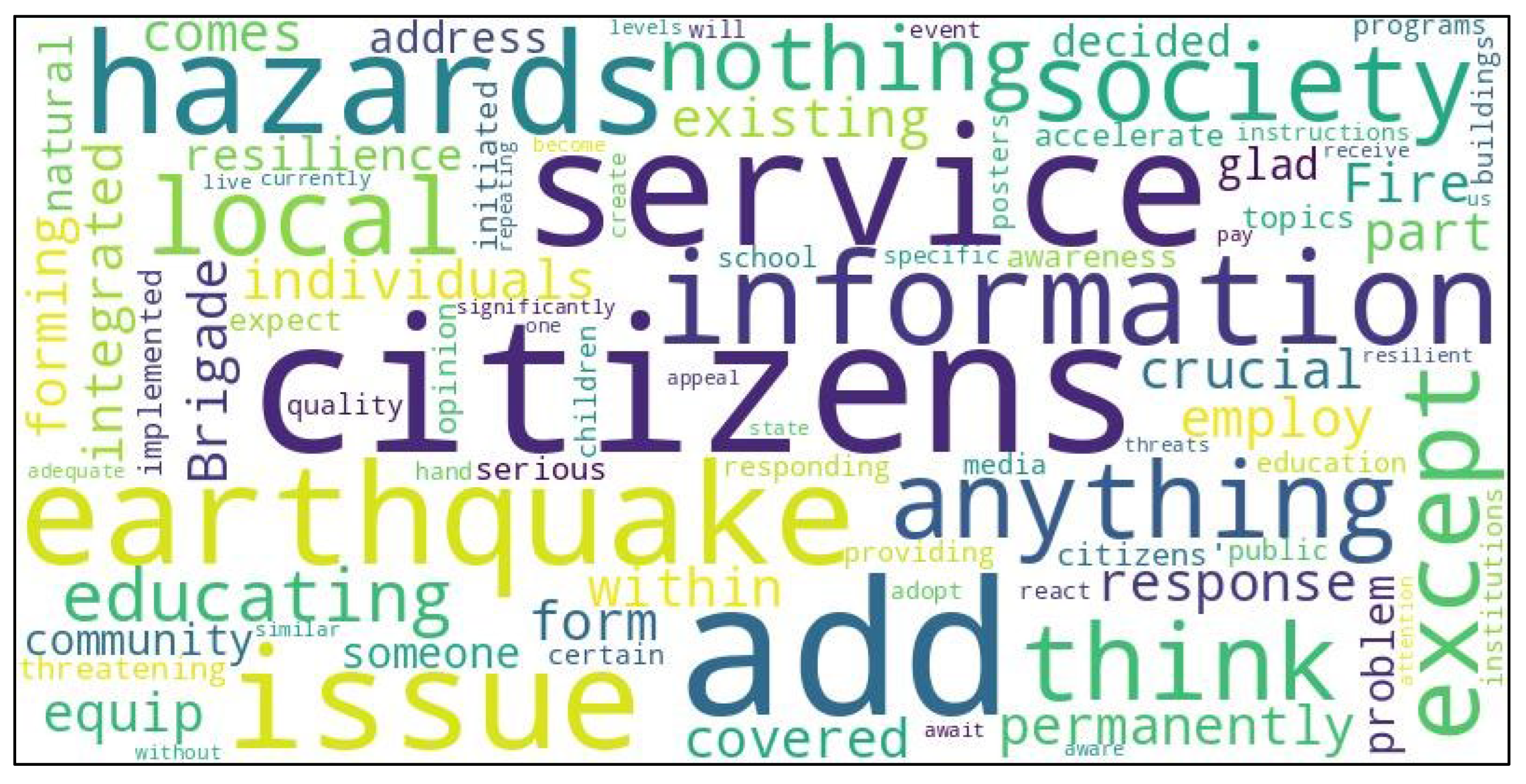1. Introduction
Local communities deploy diverse strategies to brace for seismic events, including community preparedness initiatives, counselling offerings, and evaluations of earthquake resilience among building clusters [
1,
2,
3,
4]. Notable research from Indonesia highlights the vital role of community readiness, promoting the adoption of earthquake hazard maps and disaster readiness training to strengthen resilience [
5,
6]. Further studies in Bengkulu delve into how the residential environment impacts disaster preparedness, showing the influence of settlement conditions on community readiness for seismic events [
7]. Additionally, research in the Italian Apennines explores community responses to earthquakes, particularly how varied historical exposures to seismic activity shape perceptions and preparedness efforts. This research indicates that levels of concern and readiness differ greatly depending on past experiences and the roles within the community [
8]. These insights underscore the necessity of crafting preparedness strategies that are finely tuned to the local context and distinct community characteristics [
5,
9,
10,
11,
12,
13].
Seismic resilience forms a core pillar of disaster management, focusing on improving readiness and the ability to respond in earthquake-prone areas [
14]. Research in this area highlights the necessity of assessing and enhancing resilience through diverse strategies [
15,
16,
17,
18,
19,
20,
21]. For instance, an innovative assessment framework was unveiled in Taipei City, evaluating earthquake risks and resilience in the power infrastructure based on criteria like Robustness, Rapidity, Redundancy, and Resourcefulness [
22]. In more remote areas, such as near the Dead Sea Fault in Israel, tailored self-assessment tools have been developed to foster deeper personal and family involvement in earthquake preparedness [
23]. Moreover, research in Iran emphasizes the urgent need to boost seismic resilience at educational establishments, prioritizing retrofitting initiatives to enhance resilience indicators [
24].
In Montenegro, multiple factors significantly influence the seismic resilience of structures. For high-rise buildings made of reinforced concrete (RC) along the Montenegrin coast, critical factors include inter-storey drift, wall rotations, and shear capacity, which are key in assessing their seismic performance [
25]. The resilience of such buildings also hinges on the configuration of the structural system and the classification of the seismic zone [
26]. Furthermore, the dynamic properties of these structures play an essential role in seismic design, as evidenced by comparisons with local and EC8 standards [
27]. The structural integrity of heritage masonry buildings is undermined by poor craftsmanship and the absence of routine maintenance, heightening their risk during seismic events [
28]. In regions with high seismic risk, such as Blida City, evaluations of building resilience often concentrate on vulnerability curves, states of damage, timelines for reconstruction, and related costs, all crucial for enhancing seismic resilience [
29].
Regarding that, the primary objectives of this study are to assess the current state of seismic resilience, identify critical gaps in local preparedness, and evaluate the effectiveness of existing response mechanisms. In this research, we conducted eight semi-structured interviews with individuals from regions highly prone to seismic activities, particularly those who have experienced notable earthquake impacts. Participants were chosen from various Montenegrin cities recognised for their susceptibility to earthquakes, such as Nikšić, Podgorica, Bar, Kotor, Cetinje, Budva, Herceg Novi, and Berane. To deepen our understanding and enhance the processing of data gathered from surveys on community resilience to earthquake-related disasters, conducting structured interviews was considered crucial. These interviews proved invaluable, supplementing and enriching the data obtained from questionnaires and offering more nuanced insights into local communities' resilience strategies. Each participant responded to a standardized set of questions to maintain uniformity in data collection. The interview format was designed to be flexible, adapting to the participants' responses, motivations, and engagement levels. This adaptive approach enabled an authentic exchange of views and allowed the researchers to gather a broad spectrum of personal experiences and perspectives on community resilience. This method not only generated rich qualitative data but also bolstered the study's validity by engaging directly with those most impacted by seismic events.
1.1. Literature Review
A thorough exploration of community resilience in earthquake scenarios, as found in scholarly literature, highlights various critical aspects. Researchers emphasize the crucial role of structural components—including buildings, hospitals, schools, and other infrastructure—in coping with the consequences of seismic disturbances [
30]. Evaluating the resilience of buildings is deemed essential for the overall resilience of communities, with factors like repair costs, occupancy rates, and asset values being key indicators [
31]. Effective earthquake disaster management involves community participation to enhance adaptive behaviors, underscored by risk awareness, education, disaster mitigation, and collaborative efforts between residents, government agencies, and other stakeholders [
32]. Community resilience is about overcoming shared challenges and trauma, relying on social networks, technological innovations, and strong infrastructural support [
33]. Assessing seismic resilience in groups of buildings involves scrutinizing potential hazards, appraising the performance of individual buildings, and collectively evaluating the resilience of these clusters [
7].
Also, research into earthquake resilience covers a broad spectrum of topics, including structural design principles, community preparedness, the resilience of healthcare systems, and the application of seismic isolation techniques [
34]. These studies reveal significant shortcomings in traditional seismic design methods [
34], emphasize the essential role of community resilience in disaster risk management [
30], highlight the critical need for robust healthcare systems to respond effectively after earthquakes [
35], and discuss how seismic isolation can help create communities that are sustainably resilient to such natural disasters [
36].
Furthermore, studies on earthquake preparedness, particularly among residents in rural areas affected by events like the 2008 Wenchuan earthquake in China, have been extensive [
37,
38,
39]. These studies have pinpointed key factors that influence how individuals prepare for such disasters. These include access to independent information about earthquakes, understanding of seismic risks, confidence in personal and community response capabilities (self-efficacy and collective efficacy), general knowledge about earthquakes, outcome expectations, the availability of social support, and established normative beliefs [
1,
2,
12,
15,
36,
39,
40,
41,
42,
43,
44,
45,
46,
47,
48,
49,
50,
51,
52]. Findings indicate that individuals who possess a comprehensive understanding of disaster management are more likely to act decisively, such as evacuating promptly or quickly resuming their usual activities post-disaster, compared to those with limited knowledge, who may delay action while waiting for further instructions [
1,
2,
12,
15,
36,
39,
40,
41,
42,
43,
44,
45,
46,
47,
48,
49,
50,
51,
52].
Strategies for local governance that enhance seismic resilience are critical in preparing urban and regional communities to effectively manage and recover from the impacts of earthquakes. These strategies are crucial for minimizing seismic damage and fostering sustainable development in areas prone to earthquakes. Central to these strategies are preventive measures where urban policies require buildings and infrastructure to be reinforced to withstand seismic shocks. These actions protect the immediate environment and contribute to the long-term resilience of the community [
53].The effectiveness of local governance in fostering seismic resilience can vary greatly, depending on regional planning. Authorities may develop diverse, customized plans that cater to their specific environmental and seismic challenges, underscoring the importance of personalized resilience strategies [
54].
At the community and structural level, incorporating resilience goals into the seismic design of buildings and urban planning significantly enhances the speed of recovery after earthquakes. This approach combines community-centric resilience strategies with precise engineering practices to better protect and serve the population during seismic events [
55]. Furthermore, developing evaluation models to assess seismic resilience is crucial. These models take into account various important factors, including recovery speed, the effectiveness of disaster relief efforts, and the demographic and economic traits of the area, aiding in the refinement of emergency plans [
56]. Incorporating systems dynamics within governance frameworks can enhance the understanding and development of seismic resilience. This technique is particularly useful in modern contexts like Society 5.0, where new technologies and societal needs are merged to optimize disaster management [
57]. In places like Tabriz City or regions previously impacted by disasters such as the Gorkha Earthquake, governance strategies are specifically tailored to address the unique environmental and societal challenges, ensuring effective and customized resilience measures [
58].
2. Methods
The primary objectives of this study are to assess the current state of seismic resilience, identify critical gaps in local preparedness, and evaluate the effectiveness of existing response mechanisms. In this research, we carried out eight semi-structured interviews with individuals from regions highly prone to seismic activities, particularly those who have experienced notable earthquake impacts. To acquire a more thorough and nuanced understanding, essential for effectively processing the data gathered from the survey on citizens' resilience to earthquake-induced disasters, it is nearly impossible to justify without conducting adequately structured interviews. These interviews serve as indispensable tools in complementing the questionnaire data, allowing for a more comprehensive examination of citizens' perspectives on the resilience of local communities in responding to earthquakes.
For this specific purpose, eight interviews were conducted with citizens hailing from the localities most vulnerable to seismic activity and those that have borne the brunt of earthquake consequences. The interviews engaged collaborators from Nikšić, Podgorica, Bar, Kotor, Cetinje, Budva, Herceg Novi, and Berane. Each collaborator was presented with an identical set of questions, following which the conversation was guided by participants' inclinations, motivations, level of engagement, and sincerity.
Employing a semi-structured approach, these interviews were designed around a conversation guide that mirrored the conceptual framework of the questionnaire (
Figure 1): How would you define citizen resilience in responding to natural disasters, particularly those triggered by earthquakes? What components do you believe it should encompass?; 2. What is your overall perspective on the level of citizen resilience in addressing earthquakes as natural disasters? Please provide a detailed explanation of your viewpoint.; 3. Regarding citizens' resilience in the face of earthquake disasters, what is your general assessment of their knowledge about earthquakes? Kindly elaborate on your opinion.; 4. Concerning citizens' preparedness for earthquake disasters, what is your general assessment regarding their stockpiling of food and water supplies? Please elaborate on your viewpoint.; 5. Regarding citizens' readiness for earthquake disasters, particularly at the household level, what is your general perspective on the effectiveness of oral or written disaster preparedness plans? Please provide a detailed explanation.; 6. In terms of citizens' readiness for earthquake disasters, what is your general perspective on their engagement in activities such as evacuation drills? Please elaborate on your viewpoint.; 7. How do you evaluate and what factors, in your opinion, influence citizens' motivation to undertake specific resilience measures in response to earthquake disasters? Kindly provide a detailed explanation.; 8. What, in your opinion, are the primary obstacles preventing citizens from implementing certain resilience measures in response to earthquake disasters? Please elaborate on your viewpoint.; 9. How would you assess the resilience of local self-governments in responding to earthquake disasters? Kindly provide a detailed explanation of your opinion.; 10. In your view, what strategies could be implemented to enhance citizens' resilience in responding to earthquakes as natural disasters, particularly in terms of knowledge, preparedness supplies, preventive measures, and possession of plans? Please provide a detailed explanation.; 11. Based on your observations, what is the resilience level of households in Montenegro in responding to earthquake disasters? Please provide a detailed explanation.; 12. What specific actions do you believe local self-governments should take to elevate citizens' resilience levels in responding to earthquakes? Please elaborate on your opinion.; 13. How do you assess citizens' awareness of specific preventive measures in responding to earthquake disasters, and what factors do you believe influence this awareness? Please provide a detailed explanation. This guide encompassed inquiries delving into various aspects of citizens' and local communities' resilience in the face of earthquake hazards.
After the interviews, participants were allowed to offer additional insights concerning the resilience of citizens in responding to natural disasters caused by earthquakes in Montenegro (
Figure 2). Before initiating the interviews, participants were administered a demographic questionnaire. They were provided with detailed explanations regarding the objectives of the conversation, ensuring a clear understanding of the discussion's purpose. Furthermore, participants were informed that the interviews were conducted with ordinary citizens, not specialists in the field relevant to the questions posed. This clarification aimed to alleviate any pressure associated with providing "correct" answers, emphasizing instead the value of their unique perspectives and experiences.
Moreover, participants were briefed on the rationale behind audio recording the conversations. This method not only aimed to streamline the data collection process but also to facilitate a more fluid and natural exchange compared to relying solely on note-taking. Additionally, participants' consent for audio recording was sought, and their anonymity was guaranteed to foster an environment conducive to open and honest dialogue.
2.1. Study Area
Montenegro's topography presents a labyrinth of complexities when viewed through the lens of geotectonics (
Figure 3a). The convergence of tectonic plates within this region sparks a perpetual state of geological flux, a phenomenon dating back to the onset of Alpine orogenesis and persisting to the present day. Through exhaustive geological and geophysical inquiries, bolstered by the insights gleaned from geological cartography and satellite imagery, the foundational geotectonic attributes of Montenegro's terrain emerge. This rugged landscape showcases meticulous zoning of geological formations, with the dominant tectonic masses aligning themselves in a steadfast northwest-southeast trajectory. Layers of rock gracefully incline towards the northeast, while the majestic folds thrust towards the southwest, creating a tapestry adorned with a plethora of anticlinal and synclinal structures, interspersed with thrusts, minor nappe structures, and faults [
59,
60]. Delving deeper into the geological fabric of Montenegro unveils a tapestry woven from distinct structural tectonic units, as illuminated by a comprehensive study exploring the nexus between geological formations and potential calamities in the region [
61].
The para-autochthonous tectonic unit, known by various monikers such as the Adriatic, Adriatic-Ionian, Dalmatian, or Southern Adriatic unit, envelops the most prominent swathes of Montenegro's coastline. Stretching from Grbalj to Luštica and Kobilica, this unit extends its reach to the expanse between Bar and Ulcinjska Bojana, housing regional thrust systems that have been meticulously catalogued during the pursuit of oil exploration. These systems reveal a landscape teeming with overturned and reverse-overturned structures, bordered to the northeast by the formidable Budva-Cukalj zone. Surface features such as Volujica-Šasko Lake, Možura-Briska Mountain, and Bijela Mountain stand as testaments to the geological diversity, with Cretaceous carbonates and Eocene flysch sediments adorning their cores [
59,
60].
Meanwhile, the Budva-Cukalj zone traces a sinuous path along Montenegro's coastal fringes, spanning from Sutomore in the northwest to the undulating slopes of Orjen, Lovćen, Sutorina, and Rumija, before traversing through Albania to Greece. Initially characterized by a rift structure, spanning a width of 40-100 km, this zone underwent a metamorphosis during the Alpine orogenesis, converging into a system of overturned isoclines, fractured and partitioned by thrusts. This region emerges as one of Montenegro's most dynamically altered terrains, a testament to the tumultuous forces shaping its geological identity.
Venturing further into Montenegro's heartland unveils the High Karst, a realm encompassing the central expanse and coastal fringes. From Rumija, Lovćen, and Orjen in the southwest to Volujak, Plužine, Durmitor, Šemolj, Kolašin, Tresnjevik, and Komovi in the northwest, this domain stands as a testament to nature's architectural prowess. Comprising the Old Montenegrin and Kučka nappe, separated by the synclinorium of Zeta, this region's geological narrative is one of juxtaposition. The Old Montenegrin unit, with its intricate anticlinorium, cascades into a mosaic of anticlinal-synclinal sets, while the Kučka unit, adorned with carbonate rocks and Durmitor flysch sediments, paints a picture of geological splendour. Lastly, the Durmitor tectonic unit, nestled in Montenegro's northeastern reaches, represents a bastion of geological intrigue. Separated from its predecessors by reverse dislocations along the Dinarides, this unit is a treasure trove of thrusts, emblematic of the region's geological dynamism [
59,
60].
Geological hazards that are caused by the tectonic movements in the Earth’s crust are called earthquakes or minor quakes. The territory of Montenegro is an area with high seismic risk, with frequent small to moderate-sized earthquakes, and occasionally very strong, devastating earthquakes (
Figure 3b,c). Countless seismic events have shaken the shores of Montenegro, yet many have slipped by unnoticed. Pliny, in the ancient corridors of the 1st century, penned an account of a cataclysmic earthquake that laid waste to Epidaurum, known today as Cavtat. The annals of history recall Duklja's torment in 518 AD when the earth convulsed beneath its feet. Kotor, in the cruel dance of fate, witnessed ruin twice over, first in 1520 and then in 1559, both times under the relentless grip of seismic fury. Legend speaks of the harrowing day of June 13, 1563, when every corner of Boka was razed to the ground by an earthquake of indeterminate magnitude, yet monstrous in its wrath. Echoes of a similar tremor resonated through Boka in 1608. The year 1667 etched its mark in blood and rubble, as Kotor, Perast, Risan, Herceg Novi, Budva, Bar, and Ulcinj succumbed to destruction. The annals bear witness to temblors of magnitude surpassing the IX degree on the Mercalli scale, their fury unleashed upon the Montenegrin coast in 1780 and 1830, and again in 1905, 1926, and 1927. These seismic convulsions not only assailed the coastline but also reverberated through the valleys of Podgorica-Skadar and Berane (Radojičić, 2008), including the devastating quake of 1979.
The earnest pursuit of seismic understanding in Montenegro traces its origins to the 19th century, when scholars meticulously chronicled the tremors that scarred their land, primarily through statistical analysis. The dawn of the 20th century heralded a new era as seismic endeavors in Serbia began to dissect macroseismic data across the Balkans, Montenegro included. The illustrious work of Jelenko Mihajlović stands as a testament to this scholarly pursuit. The genesis of Montenegro's seismic instrumentation unfolded in March 1960, with the establishment of the Seismological Observatory in Titograd, now enshrined as Podgorica. This institution, born in the crucible of necessity, evolved into the Republic Seismological Institute following the tumult of April 15, 1979 (Ivanović, 1991). Despite these strides, substantive inquiry into Montenegro's seismic landscape remained a rarity until the tragic cataclysm of April 15, 1979.
Hence, as the particularly active seismic area, the following zones should be emphasized: seismologic zones around Ulcinj and Bar, Budva and Brajići, Boka Kotorska but also immediate surroundings of Berane, the entire region of the Skadar Lake, Maganik etc. The maps of seismic re-ionization of Montenegro reflect possible seismic intensity degrees divide several zones of different seismic hazards: The southern, coastal region with Ulcinj, Skadar, Budva and Boka Kotorska zones with the possible maximum intensity (in the middle ground) of nine degrees of the MSC scale, Podgorica - Danilovgrad zone with the expected maximum intensity of eight degrees of MSC scale, the central part of Montenegro with the northern region including Nikšič, Žabljak and Pljevlja with the possible maximum intensity of seven degrees of the MSC scale, and an isolated seismologic Berane zone that may generate earthquakes with a maximum intensity of eight degrees on the MCS scale (
Figure 3b,c).
2.2. Socio-Economic and Demographic Characteristics of Respondents
The sample described in our study achieves a balanced gender representation, with males and females each comprising 50% of the participants. The age range of the respondents is quite broad, from young adults at 22 years to seniors at 60, providing a comprehensive look at various life stages and their potential influence on disaster responses. The participants' educational levels vary widely, from those with secondary professional training to individuals holding PhDs, allowing us to explore how educational attainment impacts disaster preparedness and resilience. Employment statuses within the sample are diverse: 25% are fully employed, 12.5% work part-time, 12.5% are students, 12.5% are self-employed, 12.5% are unemployed, and 25% are retired. This variety reflects a range of economic conditions, which could affect their preparedness for emergencies. Marital status varies among the group, with 25% married, 37.5% single, 12.5% divorced, and 25% widowed, providing insights into how different social support structures related to marital status may influence resilience. The income levels among participants range from 300€ to 1150€ per month, highlighting varied economic conditions that could impact their ability to invest in disaster preparedness measures. Geographically, the sample spans various urban and rural areas in Montenegro, potentially affecting their exposure to and experience with natural disasters, which could further influence their perspectives on resilience. Overall, this diverse demographic and socioeconomic composition of our sample allows for an enriched analysis of factors influencing disaster resilience across different segments of the population (
Table 1).
3. Results
Frequency analysis of key terms in respondents' answers regarding citizen resilience to earthquakes reveals several pivotal themes. Predominantly cited words in the responses include "Education" (5), "Response" (5), "Knowledge" (4), "Training" (4), and "Preparedness" (4). This underscores the necessity of educating citizens and implementing comprehensive educational programs to equip them with the necessary skills for responding to earthquakes effectively. Furthermore, terms such as "Adequate" (4), "Institutions" (3), and "Coordination" (3) are recurrent, highlighting the critical role of collaboration between citizens, local institutions, and governmental bodies in mitigating the adverse impacts of earthquakes. Phrases like "Capability" (3) and "Earthquake" (3) also feature prominently, stressing the importance of developing individual and collective capacities to address potential earthquake hazards. These findings underscore the importance of adopting a holistic approach to education, training, and coordination across various levels of authority to bolster citizen resilience to earthquakes. These recurring themes shed light on crucial aspects related to citizen resilience to earthquakes, with a focus on education, response readiness, preparedness, and collaboration with institutions. This analysis can serve as a valuable guide for identifying key areas requiring further attention in the planning and implementation of earthquake resilience measures (
Table 2 and
Figure 4).
After analyzing the provided responses, we observe that the key segments most frequently mentioned relate to the lack of an educational system and citizen awareness of earthquake hazards. The majority of responses highlight societal unpreparedness, lack of training, and insufficient communication with citizens as key factors contributing to low earthquake resilience. Empathy and solidarity are also identified as important components of societal resilience but are rarely mentioned in the analyzed responses.
In more detail, out of the eight analyzed responses, in five responses (62.5%), the lack of an educational system in preparing citizens for earthquakes is emphasized, while in two responses (25%), the lack of information and training for citizens, especially children, is specifically highlighted. Communication with citizens is mentioned in four responses (50%) as another key segment that lags behind, while specific plans of institutions and measures to increase resilience are mentioned in only two responses (25%). Empathy and solidarity in society are mentioned in only one response (12.5%). These results indicate the need for strengthening educational programs and media campaigns to increase citizen awareness of earthquakes and their consequences. Additionally, the importance of active communication by institutions with citizens is emphasized to raise awareness of potential hazards and proper behavior in the event of an earthquake (
Table 3 and
Figure 5).
Upon examining respondents' perspectives on the overall citizen resilience in facing earthquakes as natural disasters and their knowledge about earthquakes, a prevailing consensus emerges: the populace's understanding of earthquakes remains notably deficient. This deficiency is attributed to several factors, including inadequate education, both within formal schooling systems and through other channels, as well as a lack of comprehensive and timely dissemination of information about earthquake-related activities that could contribute to increased public awareness.
Some respondents point out that the general populace's knowledge about earthquakes is rudimentary and superficial, while others argue that time constraints and the demands of daily life hinder deeper engagement with this subject. Suggestions for addressing this issue span a spectrum of approaches, ranging from educational initiatives targeting all age groups to diverse communication strategies, such as school curricula enhancements, workshops, training sessions, broadcasts, and community outreach programs.
The overarching analysis underscores the pressing need for intensified educational endeavours and more effective dissemination of information about earthquakes. These efforts are deemed essential for elevating citizen resilience and preparedness in the face of such natural disasters (
Table 4 and
Figure 6).
The quantification of the frequency of occurrence of certain themes in respondents' answers to questions reveals the following results: a) Lack of education about earthquakes: This theme appears in all responses and stands out as a dominant theme. Key words related to this theme in responses include "insufficient education," "lack of information," and "low awareness"; b) Lack of educational programs: Also present in all responses, emphasizing the need for better distribution of educational programs about earthquakes. Keywords in this context include "scientific-educational broadcasts," "educational approach," and "training programs"; c) Citizens' unpreparedness: This theme appears in several responses, highlighting the lack of awareness and readiness of citizens to react in the event of earthquakes. Keywords related to this theme include "unpreparedness," "lack of risk awareness"; d) Need for continuous education: Respondents emphasize the need for ongoing education about earthquakes to increase citizens' awareness and preparedness. Keywords related to this theme include "continuous education," "ongoing information"; e) Lack of time and routine: This theme appears in several responses, indicating that daily obligations and routine hinder the process of education and earthquake preparedness. Key words used about this theme include "lack of time," and "daily obligations."
The frequency of occurrence of these themes in respondents' answers can be expressed in percentages or as the number of occurrences relative to the total number of responses. For example, the theme "Lack of education about earthquakes" appears in 100% of responses, while the theme "Citizens' unpreparedness" may appear in 25% of responses. These values can be useful for further analysis and planning of educational campaigns about earthquakes (
Table 5 and
Figure 7).
Analysis of respondents' attitudes regarding households' resilience to earthquakes in terms of verbal/written protection and rescue plans reveals the following: a) lack of awareness: the majority of respondents emphasize insufficient awareness among citizens about household protection and rescue plans. Keywords related to this theme are "unawareness," "lack of knowledge," and "lack of risk awareness." This theme is present in 100% of responses; b) lack of practical steps: respondents point out a lack of concrete and practical steps in implementing protection and rescue plans.
Key words related to this theme are "lack of action," "lack of practical steps," and "invisible measures." This theme appears in 75% of responses; c) sense of security: respondents also mention a sense of security that can lead to neglecting protection and rescue plans. Key words related to this theme are "sense of comfort," "security," and "trust that a disaster will not happen."
This theme occurs in 50% of responses; d) lack of attractiveness of plans: some responses indicate a lack of attractiveness of written protection and rescue plans for citizens. Keywords related to this theme are "unappealing plans," and "lack of attractiveness of plans." This theme appears in 50% of responses; e) informal communication: there is an opinion that information about protection and rescue plans is conveyed through informal communication, but formal education and distribution of plans are lacking. This theme is present in 50% of responses.
Overall, the analysis indicates a significant lack of awareness and practical steps regarding household protection and rescue plans, pointing to the need for improving education and implementing concrete measures to increase citizens' resilience to earthquakes (
Table 6 and
Figure 8).
In the analysis of respondents' attitudes towards citizens' resilience to respond to natural disasters caused by earthquakes in terms of practising specific activities (evacuation), we observe the following results: a) a very small number of respondents (one) emphasize the existence of previous services and exercises conducted in case of danger. However, today there is a perceived lack of such organizations, leading to less comprehensive education and citizens' ability to respond; b) a very small percentage of respondents (one) state that citizens do not conduct evacuation exercises in case of earthquakes at all, and another is not familiar with conducting such activities; c) several respondents expressed the opinion that documents and plans exist, but there are no activities such as training and education to help citizens react better in case of a disaster. This indicates a disproportionate relationship between the existence of resources and their application in practice; d) some respondents emphasize that there was a practice of conducting exercises in the past, but today it is very rare or nonexistent. They also propose introducing exercises in various institutions such as schools, hospitals, and government agencies; e) the majority of respondents (four) express uncertainty or lack of knowledge about conducting exercises to respond in case of earthquakes, suggesting the need for increased awareness and education on this topic. Overall, the results indicate a significant lack of awareness and ability of citizens to respond to earthquakes through evacuation exercises. This result highlights the need for improvement in training and education programs to increase citizens' resilience to earthquakes (
Table 7 and
Figure 9).
In the analysis of citizens' motivation to undertake specific resilience measures in response to earthquakes, several observations emerge: a) three respondents, accounting for 25% of the total, highlight the potential of introducing educational broadcasts as a means of motivating citizens. This is suggested as an efficient way to educate and raise awareness about the dangers; b) four respondents, representing 33% of the total, emphasize the importance of educating younger members of society through workshops and educational films. This approach is considered the most effective and enduring in building the capacity to respond.; c) three respondents, comprising 25% of the total, emphasize awareness of earthquake dangers as motivation for taking resilience measures. They also propose convening forums with rescuers to share experiences and advice with citizens.; d) two respondents, accounting for 17% of the total, highlight fear as the main motivation for action, but also point out a lack of awareness about the dangers as a problem. Overall, the results indicate that awareness of the risks, education, and the possibility of receiving advice from experts are crucial for motivating citizens to take resilience measures against earthquakes.
In addition to the basic results presented, it is important to note a negative attitude towards the existing education and preparedness system for dealing with earthquakes in some responses. Respondents believe that existing mechanisms are not efficient enough and largely rely on instinctive reactions in dangerous situations. This suggests the need for a change in approach towards education and raising awareness about earthquakes.
Furthermore, it is essential to emphasize that citizens' motivation to take resilience measures may vary depending on various factors, including age, educational level, living conditions, and past experiences with natural disasters. Some respondents believe that fear is the most important motivator, while others emphasize protecting and rescuing their loved ones as the main driver for taking action.
Additionally, some responses indicate that citizens have different perceptions of earthquake risks, highlighting the need for more effort in educating and raising awareness on this important issue. While education is generally considered the most effective motivator, other factors such as dedication, solidarity, and responsibility towards the community can also contribute to increasing citizens' resilience to earthquakes (
Table 8 and
Figure 10).
In analyzing the barriers to undertaking certain resilience measures in response to earthquakes, it is observed that individuals and society at large face various challenges that can limit readiness to respond to such catastrophes. The most commonly cited barriers include a lack of information and awareness about earthquake hazards, as well as a shortage of personnel and resources for implementing education and training. Additionally, corruption and inadequate control in construction are mentioned as significant factors contributing to barriers to improving earthquake resilience. Ignorance, negligence, and disinterest among citizens, both individually and collectively, are also highlighted as barriers. These factors point to the need for better education and raising awareness of the importance of undertaking resilience measures. As seen from the analysis, the barriers to undertaking specific resilience measures in response to earthquakes are diverse and complex, requiring a holistic approach to addressing this issue (
Table 9 and
Figure 11).
In the analysis of the resilience of local government to respond to natural disasters, specifically earthquakes, noticeable barriers limit readiness and reaction to such calamities. Challenges such as a lack of personnel for education and implementation of resilience measures, inadequate political attention diverted to other issues, and limited resources to cope with the aftermath of earthquakes stand out. While there exists a certain level of preparedness, it remains minimal. Additionally, individuals express a lack of information about the activities of local government aimed at improving earthquake resilience. This lack of understanding and awareness of the risks posed by earthquakes contributes to unpreparedness for responding to such disasters. Furthermore, some local governments inadvertently dismiss the inevitability of earthquakes, leading to insufficient attention and action in planning and implementing resilience measures. Structural deficiencies in control and coordination systems are also identified as limiting factors in the preparedness of local governments. This analysis underscores the need for improved coordination and education at the local level to enhance the ability to respond to natural disasters caused by earthquakes (
Table 10 and
Figure 12).
In analyzing respondents' attitudes on how to improve citizens' resilience to earthquakes as a natural disaster in terms of knowledge, preparedness, implemented preventive measures, possession of plans, and similar aspects, a wide range of proposed measures for enhancing citizens' resilience is observed. Firstly, there is a clear emphasis on education as a crucial factor. Suggestions include the implementation of mandatory earthquake courses in schools at all levels of education, as well as the use of social networks for information delivery, especially to younger populations. The importance of distributing brochures containing information on earthquake response is also highlighted.
Secondly, there is a need to emphasise food stockpile preparedness, both at the state level and by local governments and individuals. Transparently informing citizens about the status of stockpiles and the opportunities they provide is also considered crucial. Suggestions also include introducing earthquake training and education programs into state exams, as well as organizing regular classes on this topic in schools. Thirdly, the need for regular exercises and training for citizens is mentioned to acquire skills and knowledge on proper earthquake response. Suggestions include employing permanent staff to monitor volunteers during exercises, organizing seminars, and conducting education on earthquake response.
Throughout all proposed measures, the importance of raising awareness among citizens about the importance of prevention and earthquake preparedness is emphasized, as well as strengthening institutional capacities to deal with this risk. Overall, there is a consensus that only a combination of education, training, preventive measures, and stockpile preparation will ensure greater citizen resilience to earthquakes (
Table 11 and
Figure 13).
In the analysis of attitudes regarding improving citizens' resilience to earthquakes as a natural disaster, it is observed that there is a consensus on the importance of education and information provision as a key aspect in increasing preparedness. The significance of education is emphasized as the most effective way to acquire knowledge on how to react in case of earthquakes and prepare oneself and households for possible disasters. Creating awareness about the importance of preparedness and involving citizens in activities related to resilience is an important step in building a resilient society. Alongside education, there is a prescription for creating reserves of basic food supplies at both the national and local levels, followed by providing accessible information to citizens about the status of these reserves and how they can prepare for potential catastrophes. Additional measures include mandatory educational activities through school curricula, additional courses and seminars, as well as organizing workshops and training sessions to educate citizens on crisis response. In the overall context, it appears that the focus is on adequate education, implementing measures such as training and information provision, as well as creating awareness and involving citizens in processes to enhance earthquake resilience (
Table 12 and
Figure 14).
Analyzing the opinions of respondents on what local authorities should undertake to increase citizens' resilience to earthquakes, there is a consensus on the importance of education and training. The overall focus is on raising awareness and preparing citizens for possible earthquakes. Various activities are proposed, including educational workshops, compulsory education in schools, as well as collaboration with larger firms and businesses to provide adequate equipment and training for employees. Additionally, it is suggested to direct resources towards elaborating plans to increase community resilience, as well as establishing special services or teams to respond to earthquakes. In the overall context, the proposed activities aim to educate and enhance citizens' preparedness, which would significantly contribute to increasing resilience to earthquakes (
Table 13 and
Figure 15).
Additional analysis of participants' opinions on citizens' resilience to earthquakes in Montenegro reveals diverse attitudes and suggestions for raising the level of preparedness and effective response in the event of natural disasters. Some participants emphasize the importance of hiring specialized personnel and forming services or teams dedicated to training and supporting citizens, while others propose improving the educational system by incorporating earthquake response topics into the curriculum. Their suggestions also include activities aimed at raising awareness through the media, informational campaigns, and disseminating information through various channels, including institutions. There is also a call for an active role of the state and local institutions in coordinating and supporting initiatives to increase citizens' resilience. All in all, diverse opinions provide an important contribution to the debate on this topic and offer a wide range of possible actions to raise the level of citizens' resilience to earthquakes in Montenegro (
Table 14 and
Figure 16).
5. Discussion and Recommendation
The findings from this comprehensive qualitative analysis underscore the complexities and challenges inherent in enhancing seismic resilience in Montenegro. This discussion aims to interpret the significance of local preparedness and response mechanisms as they pertain to broader seismic risk management strategies. Education and awareness about earthquake preparedness are crucial in boosting the resilience of communities [
62,
63,
64,
65]. It is evident that current educational frameworks fall short, underscoring the urgent need for robust educational initiatives that reach all demographics and utilize both school programs and social media to spread vital information [
47,
66,
67,
68]. Moreover, enhancing knowledge and awareness is essential to equip the public to handle the risks associated with earthquakes and to take proactive safety measures [
69].
The readiness of individuals to effectively respond to earthquakes is vital for reducing the impacts of such disasters [
70]. Despite some awareness of existing safety protocols, gaps remain in the practical skills and knowledge of the general public. Actual implementation of these protocols is often lacking. To address this, consistent training, practical drills, and clear evacuation communication are necessary [
71,
72,
73]. By empowering people with essential skills, we enable them to respond adeptly during earthquakes [
74]. In addition, the report points out deficiencies in formal communication channels and stresses the importance of proactive engagement by institutions. Educational campaigns and community outreach must be improved to raise awareness of earthquake risks and encourage stakeholder collaboration [
75]. As a result, strengthening communication networks is critical for delivering timely information and ensuring coordinated disaster responses [
62,
76,
77,
78,
79].
Understanding public attitudes towards earthquakes is also essential for motivating resilience measures [
80]. While some are driven by concern for their loved ones, others may need additional incentives, like educational programs and workshops, to spur action. Accordingly, the study emphasizes the need to cater to diverse motivations to foster a proactive community environment that supports earthquake resilience efforts [
81]. Additionally, several barriers obstruct the effective implementation of resilience measures, including informational, resource-based, and political challenges, as well as coordination failures [
82]. To combat these issues, a comprehensive strategy that boosts education, awareness, and institutional capabilities is necessary, while also addressing public indifference and oversight [
82].
In the pursuit of enhancing seismic resilience, this paper proposes a series of strategic recommendations designed to strengthen community preparedness and response mechanisms across various facets of society: 1) implement comprehensive educational programs that target all age groups; integrate earthquake preparedness into school curricula and utilize social networks to effectively disseminate information; 2) conduct regular training sessions and practical exercises to boost citizens' readiness and response capabilities; ensure clear communication of evacuation procedures and empower citizens through hands-on training experiences; 3) strengthen collaboration and communication between citizens, local institutions, and governmental bodies; 4) employ educational campaigns and community outreach programs to raise public awareness of earthquake risks and establish clear channels for timely information and coordinated responses; 5) recognize and address the diverse motivations and perceptions among citizens to foster proactive behavior; offer incentives like educational broadcasts and workshops, and create a supportive environment that promotes resilience through awareness, education, and community engagement; 6) tackle barriers such as information deficits, resource constraints, and political neglect through a holistic approach; enhance education, awareness, and institutional capacities to address negligence and coordination deficiencies, thereby building community resilience against earthquakes; 7) integrate earthquake-specific courses into school curricula to ensure early exposure and understanding of disaster preparedness; incorporate regular drills and exercises to familiarize students with evacuation procedures and emergency protocols; 8) conduct training sessions for households to enhance awareness and practical readiness for earthquake protection and rescue plans; provide accessible resources and information about protective measures to encourage proactive household preparedness; 9) increase public awareness of evacuation procedures through focused educational campaigns and regular drills; implement evacuation exercises across various institutions to familiarize citizens with evacuation routes and protocols; 10) foster a sense of cohesion and collective action among residents by promoting collaboration between local authorities and community members; organize workshops, seminars, and outreach programs that engage citizens in community-level disaster preparedness efforts; 11) invest in capacity-building initiatives that support local governments in coordinating and implementing earthquake resilience efforts; improve coordination mechanisms and enhance public awareness of local government activities to bolster community response capabilities; 12) tailor resilience measures to the specific contexts of local areas and prioritize vulnerable regions with limited resources; conduct needs assessments and develop customized strategies to address regional disparities in earthquake resilience; 13) incorporate cultural sensitivity into education and awareness campaigns to ensure greater acceptance and participation among diverse communities; engage community leaders and leverage local knowledge to inform decision-making processes in resilience initiatives; 14) integrate resilience considerations into development planning and decision-making processes to ensure long-term sustainability; promote multi-sectoral collaboration and mainstream resilience into policy frameworks while mobilizing financial resources for implementation and continuous improvement; 15) establish monitoring and feedback mechanisms to assess the impact of resilience interventions and identify areas for improvement; conduct regular evaluations and engage stakeholders in reflection exercises to adapt strategies based on lessons learned and foster a culture of learning and adaptation, thereby ensuring ongoing progress towards disaster risk reduction goals.
6. Conclusions
This study offers critical insights into how well Montenegro is prepared to handle disasters caused by earthquakes. Through interviews with residents across various municipalities, the study paints a detailed picture of resilience which, for the most part, appears robust, particularly against non-physical impacts of quakes. Yet, a notable minority still feels the brunt of physical damages, highlighting the ongoing need to refine and enhance resilience strategies and preventive measures. The data reveals a spectrum of experiences: while many didn't face direct physical losses from earthquakes, a significant number did experience such hardships. This points to the effectiveness of existing safety measures to some extent but also flags the need for additional research and upgrades to cover all possible impacts. The interviews shed light on varying levels of local preparedness, from adequate to severely deficient, which could crucially affect how effective response strategies are during seismic episodes.
The findings underscore an urgent need for tailored educational programs and readiness plans that cater to the unique vulnerabilities and strengths of different communities. Variability in engagement with these preparedness initiatives could influence the overall resilience of the populace. Moreover, the analysis underscores the importance of boosting public awareness and local institutional readiness to ensure a unified and effective response to future seismic challenges. In wrapping up, the study makes a strong case for a layered approach to strengthening Montenegro’s seismic resilience. This approach involves ramping up educational initiatives, ensuring readiness is uniform across municipalities, and equipping every community member with the tools to effectively tackle earthquake risks. By promoting a proactive stance on resilience, and bolstering education, infrastructure, and community involvement, Montenegro can enhance its safety protocols and preparedness, fostering a more effective response to inevitable seismic activities.
This study's scientific implications extend to enhancing our understanding of seismic resilience, particularly in regions similar to Montenegro. It contributes to the broader field of disaster (risk) management by providing a methodological framework that can be applied to assess and analyze community resilience in facing seismic challenges. Also, the nuanced insights gained from the diverse experiences of Montenegro's municipalities enrich the academic discourse on disaster preparedness, suggesting avenues for further research into localized resilience strategies and their effectiveness.
Practically, the implications of this research are immediately relevant to policymakers and emergency management professionals. By highlighting the areas where resilience is either strong or lacking, the findings can guide targeted improvements in disaster preparedness programs. The recommendation for comprehensive educational and readiness initiatives offers a blueprint for local authorities to enhance community engagement and ensure that all demographic segments are equipped with the knowledge and resources to respond to earthquakes effectively. Ultimately, this research advocates for a proactive approach to disaster management, encouraging continuous refinement of policies and practices to build a more resilient society against seismic events.
Figure 1.
Mindmap of Citizen Resilience in Earthquake Disasters in Montenegro.
Figure 1.
Mindmap of Citizen Resilience in Earthquake Disasters in Montenegro.
Figure 2.
Visual representation of predominant themes in the study of seismic resilience and local preparedness in Montenegro.
Figure 2.
Visual representation of predominant themes in the study of seismic resilience and local preparedness in Montenegro.
Figure 3.
Study area: (a) Location of Montenegro; Maps of seismic re-ionization of Montenegro territory within the return periods of 200 years (b) and the return period of 500 years (c). Based on the Institute of Hydrometeorology and Seismology of Montenegro.
Figure 3.
Study area: (a) Location of Montenegro; Maps of seismic re-ionization of Montenegro territory within the return periods of 200 years (b) and the return period of 500 years (c). Based on the Institute of Hydrometeorology and Seismology of Montenegro.
Figure 4.
Word cloud analysis of key themes in defining citizen resilience to earthquake-induced disasters.
Figure 4.
Word cloud analysis of key themes in defining citizen resilience to earthquake-induced disasters.
Figure 5.
Word cloud analysis of key themes in assessment of citizen resilience in coping with earthquake disasters.
Figure 5.
Word cloud analysis of key themes in assessment of citizen resilience in coping with earthquake disasters.
Figure 6.
Word cloud analysis of key themes in ssessment of citizens' knowledge about earthquakes and resilience.
Figure 6.
Word cloud analysis of key themes in ssessment of citizens' knowledge about earthquakes and resilience.
Figure 7.
Word cloud analysis of key themes in assessment of the effectiveness of oral and written disaster preparedness plans among citizens for earthquake readiness, particularly at the household level.
Figure 7.
Word cloud analysis of key themes in assessment of the effectiveness of oral and written disaster preparedness plans among citizens for earthquake readiness, particularly at the household level.
Figure 8.
Word cloud analysis of key themes in the evaluation of citizens' stockpiling of food and water supplies for earthquake preparedness.
Figure 8.
Word cloud analysis of key themes in the evaluation of citizens' stockpiling of food and water supplies for earthquake preparedness.
Figure 9.
Word cloud analysis of key themes in the evaluation of citizens' engagement in evacuation drills for earthquake preparedness.
Figure 9.
Word cloud analysis of key themes in the evaluation of citizens' engagement in evacuation drills for earthquake preparedness.
Figure 10.
Word cloud analysis of key themes in the evaluation of factors influencing citizens' motivation for resilience measures in earthquake disasters.
Figure 10.
Word cloud analysis of key themes in the evaluation of factors influencing citizens' motivation for resilience measures in earthquake disasters.
Figure 11.
Word cloud analysis of key themes in primary obstacles to implementing resilience measures in response to earthquake.
Figure 11.
Word cloud analysis of key themes in primary obstacles to implementing resilience measures in response to earthquake.
Figure 12.
Word cloud analysis of key themes in the assessment of local self-governments' resilience in responding to earthquake disasters.
Figure 12.
Word cloud analysis of key themes in the assessment of local self-governments' resilience in responding to earthquake disasters.
Figure 13.
Word cloud analysis of key themes in strategies to enhance citizens' resilience in responding to earthquake disasters.
Figure 13.
Word cloud analysis of key themes in strategies to enhance citizens' resilience in responding to earthquake disasters.
Figure 14.
Word cloud analysis of key themes in resilience level of households in Montenegro in responding to earthquake disasters.
Figure 14.
Word cloud analysis of key themes in resilience level of households in Montenegro in responding to earthquake disasters.
Figure 15.
Word cloud analysis of key themes in strategies to enhance citizens' resilience in responding to earthquakes by local self-governments.
Figure 15.
Word cloud analysis of key themes in strategies to enhance citizens' resilience in responding to earthquakes by local self-governments.
Figure 16.
Word cloud analysis of key themes in the assessment of citizens’ awareness and influencing factors regarding preventive measures for earthquake disasters.
Figure 16.
Word cloud analysis of key themes in the assessment of citizens’ awareness and influencing factors regarding preventive measures for earthquake disasters.
Table 1.
Demographic and socioeconomic profiles of interviewees in Montenegro.
Table 1.
Demographic and socioeconomic profiles of interviewees in Montenegro.
| ID |
Gender |
Age |
Education |
Income |
Interview Location |
Interview Duration |
Employment Status |
Marital Status |
| 01 |
Male |
58 |
Secondary
professional |
450€ |
Nikšić |
37 min |
Employed |
Married |
| 02 |
Male |
35 |
Graduate
Lawyer |
1150€ |
Podgorica |
44 min |
Employed |
Single |
| 03 |
Female |
26 |
Master's in
Geography |
800€ |
Bar |
65 min |
Employed |
Married |
| 04 |
Female |
28 |
Student/seasonal worker |
500€ |
Budva |
52 min |
Part-time |
Single |
| 05 |
Male |
45 |
PhD in Environmental Sci |
950€ |
Cetinje |
48 min |
Self-employed |
Married |
| 06 |
Female |
30 |
Bachelor's in
Economics |
700€ |
Kotor |
55 min |
Unemployed |
Divorced |
| 07 |
Male |
22 |
College student |
300€ |
Herceg Novi |
40 min |
Student |
Single |
| 08 |
Female |
60 |
Retired teacher |
600€ |
Tivat |
50 min |
Retired |
Widow |
Table 2.
Defining citizen resilience in response to earthquake-induced natural disasters.
Table 2.
Defining citizen resilience in response to earthquake-induced natural disasters.
| Participant ID |
Key Response Segments |
| 01 |
Citizen resilience to earthquakes encompasses preparedness and awareness of proper response to natural disasters. Achieving such resilience hinges crucially on possessing knowledge of protective measures and proper conduct during earthquakes. Education and practical training represent essential steps towards bolstering citizens' capacity for independent response and minimizing the adverse consequences of such natural events. |
| 02 |
Citizen resilience entails the undertaking of all available measures and activities to mitigate the consequences of earthquakes as disasters. It implies coordination between state and local authorities, citizens, and institutions most prepared and equipped to respond in given situations. As earthquakes entail both material and immaterial losses, it is imperative to initiate actions aimed at increasing the resilience of local communities in earthquake-prone areas promptly and seriously. Particularly in high-risk zones, it is necessary to introduce and prepare the population through programs and plans for responding to such situations. |
| 03 |
Citizen resilience in responding to natural disasters, especially earthquakes, represents the ability of all organs and institutions in local self-governance to react adequately to mitigate the consequences that earthquakes may cause. To this end, it is essential to involve all physically capable citizens who, through specific types of education and training, would be ready to respond in the event of an earthquake. |
| 04 |
Resilience encompasses all preventive actions that society and citizens undertake to secure safer environments in the event of natural disasters, such as earthquakes. These actions may involve organizing citizens to familiarize them with the consequences of earthquakes and preparing them to act appropriately in such emergencies, thereby reducing the negative consequences of this phenomenon. In essence, it's about creating a community capable of responding adequately to earthquakes as disasters. |
| 05 |
Citizen resilience in responding to natural disasters caused by earthquakes involves adequate response in the event of earthquakes. This can be achieved if we have capable individuals who know how to react in such situations, as well as the knowledge and ability of citizens to react in such situations. |
| 06 |
Citizen resilience in responding to natural disasters caused by earthquakes is reflected in the ability, readiness, knowledge, will, and desire of citizens to respond in the event of earthquakes. |
| 07 |
Resilience represents the society's strength to cope with disasters, implying general preparedness and readiness for an adequate response from all institutions and citizens in given situations. Institutions are expected to react professionally, while citizens are expected to show solidarity. |
| 08 |
Citizen resilience could be seen as the organized readiness of society to respond adequately to natural disasters caused by earthquakes. It involves implementing knowledge, preparation, and training aimed at achieving better preparedness for responding in the event of earthquakes. |
Table 3.
Assessment of citizen resilience in coping with earthquake disasters.
Table 3.
Assessment of citizen resilience in coping with earthquake disasters.
| Participant ID |
Key Response Segments |
| 01 |
Low earthquake preparedness in society is highlighted by inadequate coverage of the topic in the media and educational system. Limited educational programs on television and the absence of training in schools, particularly for children, result in a lack of knowledge and skills necessary for appropriate responses. Communication with citizens is minimal, falling short of addressing their needs and the associated hazards. Consequently, citizens, lacking education and proper resources, are left to rely on instinctive reactions during earthquakes. |
| 02 |
Except for the aftermath of the significant earthquake in 1979, little attention has been devoted to fostering a resilient society against earthquakes. Most citizens remain uneducated and uninformed about the dangers posed by these natural events, posing a significant challenge when attempting to implement initiatives to acquaint citizens with these hazards and their repercussions. |
| 03 |
Considering earthquakes demand swift responses, citizens should at least be familiar with proper reaction methods. Unfortunately, it appears that this awareness remains at a very low level, limited to a few basic directives on actions and responses, making it challenging to definitively assess the level of resilience. However, this issue certainly warrants increased attention. |
| 04 |
Regrettably, it seems we have yet to establish a society resilient enough to withstand such occurrences. In the face of disasters, we mostly rely on regional assistance, indicating our lack of self-reliance and readiness to tackle such difficulties, including those caused by earthquakes. Consequently, it is evident that as a society, our level of resilience in citizen response to earthquakes and overall preparedness for natural disasters caused by earthquakes is not commendable. |
| 05 |
Citizens are not adequately informed about how to respond in the event of natural disasters caused by earthquakes. This is largely due to insufficient dissemination of information through media channels, brochures, flyers, social networks, etc. Consequently, it can be concluded that as a society, we lack the necessary awareness and education on how to react in the event of earthquakes, resulting in a low level of citizen resilience in responding to natural disasters caused by earthquakes. |
| 06 |
In my view, the level of resilience is satisfactory. While there are services responsible for earthquake response, enhancing resilience would involve better informing citizens about their roles and contributions during earthquakes. |
| 07 |
In my opinion, resilience is not at a high level. Institutions compete for political gains, while citizens increasingly distance themselves from one another, painting a negative picture. In a time where empathy and solidarity are dwindling, there is a lack of inclination to aid or even listen to others in need. |
| 08 |
Unfortunately, the level of resilience is not commendable. This conclusion is drawn from observations in our city and country. There is a noticeable absence of efforts to build a more resilient society against earthquakes, indicating a lack of preparation and implementation of measures to increase resilience. |
Table 4.
Assessment of citizens' knowledge about earthquakes and resilience.
Table 4.
Assessment of citizens' knowledge about earthquakes and resilience.
| Participant ID |
Key Response Segments |
| 01 |
In my assessment, citizens' understanding of natural disasters stemming from earthquakes remains at a distressingly low level. As I previously discussed, the root of this issue lies primarily in the inadequacies of formal education, particularly within schools where earthquake preparedness should be a mandatory component. Additionally, supplementary initiatives such as workshops, training sessions, and informative broadcasts are crucial to bolstering public knowledge. However, even when such efforts are undertaken, there persists a significant gap in informing citizens about these activities, presenting a challenge comparable to the lack of their execution. |
| 02 |
Building upon my earlier response, I emphasized the insufficiency in disseminating information and the sluggish implementation of educational endeavours aimed at enhancing public awareness. Moreover, there exists a scarcity of scientific and educational programs targeting older demographics, utilizing social media platforms to educate the younger generation, and incorporating earthquake-related curricula into schools. |
| 03 |
As I mentioned previously, I contend that substantive knowledge on this topic is scarce beyond a few instinctual responses based on hearsay, such as avoiding elevators or seeking shelter under door frames. I question whether the average citizen has been exposed to more comprehensive information through educational campaigns. |
| 04 |
This issue transcends our society; many countries, regardless of their level of development, grapple with similar hurdles. The increasingly routinized lifestyles and dwindling interpersonal interactions in both developed and developing nations contribute to a decline in empathy and willingness to assist others in times of need. Daily routines have alienated us from matters deemed "secondary," neglecting vital aspects of personal and communal significance. Consequently, citizens lack knowledge due to detachment and apathy toward objectively crucial matters, which is not unique to our context. The scarcity of time in today's fast-paced world exacerbates this problem, resulting in the neglect of critical issues like earthquake preparedness. |
| 05 |
As previously stated, I believe citizens possess only a rudimentary understanding of earthquakes, capable of explaining the basic concept and potential consequences in broad strokes. However, I doubt many individuals, especially those outside professional circles, possess a deeper comprehension of earthquake-related subjects. |
| 06 |
In my view, citizens' capacity to respond to earthquakes, as it pertains to their understanding of earthquakes, is notably deficient. This conclusion stems from the widespread lack of education about earthquake-related disasters, compounded by an inadequate grasp of appropriate responses in earthquake scenarios. The dearth of effective communication channels for educating citizens about their preparedness, particularly regarding earthquake awareness, exacerbates this situation. |
| 07 |
Absolutely none! Can you tell me where one could gain such knowledge, aside from taking the initiative themselves? And that's something sorely lacking nowadays. Hence, we must instil this knowledge in our populace from early childhood through retirement. Let's not forget 1979; history could repeat itself. On another note, observe the chaotic situation in Cetinje, not to mention the coastal regions grappling with rampant construction. |
| 08 |
In my estimation, the prevailing sentiment is that earthquakes are not perceived as a potential risk; citizens believe such disasters cannot occur here. Consequently, citizens' preparedness, particularly in terms of their understanding of earthquakes, is remarkably low. |
Table 5.
Evaluation of citizens' stockpiling of food and water supplies for earthquake preparedness.
Table 5.
Evaluation of citizens' stockpiling of food and water supplies for earthquake preparedness.
| Participant ID |
Key Response Segments |
| 01 |
If we consider the opportunity we had to witness the extent of citizens' stockpiles during the coronavirus pandemic, we can conclude that preparations were very poor. The difference is that citizens had time to react and replenish their supplies in the first scenario, whereas in the case of stronger earthquakes, this is often impossible due to the extensive damage. Once again, I would like to refer to state and local institutions, which could have learned from the pandemic example to identify issues that our society faces in similar situations. |
| 02 |
I believe that possession of stockpiles in the form of food and water is at a very low level, often limited to basic daily necessities. Citizens don't prioritize the possibility of a stronger earthquake occurring, as they primarily focus on everyday matters, believing that such events either won't happen or won't affect them directly. |
| 03 |
I think that serious stockpiling efforts are not being made, especially in urban households where numerous supermarkets are readily available, and thoughts of natural disasters are almost nonexistent. In rural households, I presume the situation is different, considering that agriculture is one of the main activities, leading to stockpiles of vegetables, homemade meat, and the like. |
| 04 |
As I mentioned before, we live fast-paced lives and don't have time for some basic things and activities. Yet, readily available items are easily accessible. People no longer buy large quantities of food but rather what is needed for, let's say, a week. Therefore, I believe that in a more serious sense, we cannot talk about stockpiles. |
| б05 |
I believe that the situation is alarming in this regard as well. I'm not sure if there is still time for food stockpiling, considering that freezers are almost nonexistent and canned food is no longer as attractive as it used to be. Therefore, I think that very few households make food reserves, especially out of fear of a natural disaster like an earthquake. |
| 06 |
The same goes for none! People live from hand to mouth, focusing on the present without considering stockpiles. Perhaps if someone has relatives in the countryside or prepares preserves for the winter, if we can classify that as stockpiling, besides that, it's hard to find anyone with ready supplies for a longer period. |
| 07 |
The answer is the same as before. Citizens are not aware that we are in an earthquake-prone area, mainly because the last major earthquake with significant consequences happened almost half a century ago, so citizens became complacent regarding this issue. That's why serious food and water reserves are not being created, as we noticed even a couple of years ago during the pandemic when supermarkets were full of citizens and shelves were empty. Therefore, there were no reserves; people reacted in the given moment. |
| 08 |
If we consider the opportunity we had to witness the extent of citizens' stockpiles during the coronavirus pandemic, we can conclude that preparations were very poor. The difference is that citizens had time to react and replenish their supplies in the first scenario, whereas in the case of stronger earthquakes, this is often impossible due to the extensive damage. Once again, I would like to refer to state and local institutions, which could have learned from the pandemic example to identify issues that our society faces in similar situations. |
Table 6.
Assessment of the effectiveness of oral and written disaster preparedness plans among citizens for earthquake readiness, particularly at the household level.
Table 6.
Assessment of the effectiveness of oral and written disaster preparedness plans among citizens for earthquake readiness, particularly at the household level.
| Participant ID |
Key Response Segments |
| 01 |
My opinion is that citizens' resilience in responding to natural disasters caused by earthquakes in terms of verbal/written protection and rescue plans is very poor. Once again, we have the same problems as in previous situations: lack of awareness, and unawareness of the consequences earthquakes bring. The last significant earthquake in our area occurred in 1979, and at that time, part of the population was educated. However, the vast majority of citizens living in Montenegro today are not aware of the danger posed by earthquakes. Consequently, households do not develop sufficiently good communication when it comes to these dangers. The reason for this is a sense of comfort and security that such a catastrophe will not happen, which is again a consequence of lack of information and ignorance. |
| 02 |
If there are a certain number, I doubt even more, printed brochures in the form of protection and rescue plans, I believe even less that citizens have preserved them, let alone put them in a visible place and pay attention to them. As for verbal plans, considering that there have been strong earthquakes in the immediate vicinity recently, the knowledge they have acquired is perhaps from reporting from the scene or TV programs on this topic. |
| 03 |
As a person living in this country, I am aware that there is a protection and rescue plan issued by the Government of Montenegro, but I have not noticed any concrete and practical steps. So, we possess a document, but besides that document, available on the website of the Government of Montenegro, I do not see concrete actions for that document to reach a larger number of citizens. |
| 04 |
I think we have insufficient information regarding these issues. I assume that we have appropriate documents, and elaborates, but citizens themselves are deprived of that information because they mostly consider it insignificant. This is a natural phenomenon that may or may not happen soon, so it is set aside, which is a big problem because an earthquake can happen any minute, and we as citizens are neither aware of that nor do we find it important because we believe it will not happen. So, I think it's a big problem that written protection plans are not attractive enough for citizens, while verbal ones are very few, or they do not exist at all. |
| 05 |
I think it boils down to some informal communication; if one hears that a devastating earthquake has occurred somewhere in the world, it might be discussed within the family circle. But a specific conversation aimed at education, conveying, and sharing knowledge, I think, is not present. |
| 06 |
We live alienated lives. Communication, even with relatives, is reduced to a minimum, so I do not believe that discussions on these topics take place, while written plans are completely excluded. |
| 07 |
This is related to the question of education. Considering that there is no awareness, or knowledge of how to react, I think protection plans do not exist in households either. I believe they would only have instinctive reactions. |
| 08 |
I think there are no plans at the household level. I myself have not made a plan, neither written nor verbal, and I believe the majority of citizens have not either. If there is perhaps a poster with an evacuation plan in case of a fire in buildings, I think that is the only type of "plans." |
Table 7.
Evaluation of citizens' engagement in evacuation drills for earthquake preparedness.
Table 7.
Evaluation of citizens' engagement in evacuation drills for earthquake preparedness.
| Participant ID |
Key Response Segments |
| 01 |
Once upon a time, there existed a service known as Civil Protection, which regularly conducted exercises to prepare citizens for potential dangers. Through these exercises, citizens were educated and equipped with the necessary skills to respond effectively in hazardous situations. Unfortunately, in today's context, similar governmental bodies or organizations are either nonexistent or limited to rescue services and fire departments. Consequently, it appears that citizens are largely left to rely on their instincts and reflexes when faced with dangers such as earthquakes. |
| 02 |
In my opinion, there is a glaring lack of evacuation exercises being conducted by citizens from their homes in the event of earthquakes. I am almost certain that this practice is not commonplace in households across Montenegro. |
| 03 |
Expanding on the previous point, while we may possess documents outlining emergency procedures, there seems to be a significant gap when it comes to actual implementation. There is a notable absence of training, educational initiatives, or efforts to raise awareness about the importance of knowing how to react in emergency situations. At least from my perspective, I have not encountered any such activities. |
| 04 |
To be frank, I am not aware of any ongoing exercises of this nature, but I strongly believe they should be taking place. If my information is incorrect, it is because I have not personally witnessed any exercises of this kind. |
| 05 |
I am aware that in the past, during the time of the SFRY, there was an entity called Civil Protection tasked with responding to various hazardous situations. They underwent training and were knowledgeable about how to react in specific scenarios. Whether a similar organization still exists today is unknown to me, but I believe it would be incredibly beneficial if it did. I assume that the responsibilities of Civil Protection may now fall under the jurisdiction of the Protection and Rescue Service. |
| 06 |
In my humble opinion, based on my limited experience, information, and knowledge in this field, it appears that citizens are not actively engaged in such preparedness activities. I can only deduce that my lack of awareness regarding these matters may stem from a lack of commitment from relevant institutions and authorities to provide citizens with the necessary knowledge and skills. |
| 07 |
Furthermore, it seems that opportunities to participate in such exercises have significantly diminished over time. While we may have had access to exercises conducted by firefighters in the past, these events are now scarcely remembered. It is my firm belief that evacuation exercises should be implemented across all institutions where large numbers of people gather, including schools, government offices, hospitals, and more. |
| 08 |
Considering the discontinuation of mandatory military service, civil protection, and similar bodies, it is evident that there is a gap in preparedness training for citizens. |
Table 8.
Evaluation of factors influencing citizens' motivation for resilience measures in earthquake disasters.
Table 8.
Evaluation of factors influencing citizens' motivation for resilience measures in earthquake disasters.
| Participant ID |
Key Response Segments |
| 01 |
In analyzing citizens' motivation to undertake specific resilience measures in response to natural disasters caused by earthquakes, several key observations emerge. Firstly, three respondents highlight the potential of introducing educational broadcasts as a means of motivating citizens. This suggests that disseminating information through such channels could serve as an effective method of educating the populace about potential dangers. |
| 02 |
Secondly, four respondents emphasize the importance of educating younger members of society through workshops and educational films. This approach is deemed the most effective, long-lasting way to instil response capabilities. |
| 03 |
Thirdly, three respondents stress the importance of earthquake awareness as a motivation for taking resilience measures. Additionally, they propose organizing forums with rescuers to share experiences and advice with citizens. |
| 04 |
Lastly, two respondents underscore fear as the primary motivation for action but also highlight a lack of awareness about the dangers of earthquakes as a problem. Collectively, these results demonstrate that awareness of risks, education, and the opportunity to receive advice from experts are crucial motivators for citizens to take resilience measures in response to earthquakes. |
| 05 |
In addition to the primary findings outlined above, it is noteworthy that some responses express a negative attitude towards the existing education and preparedness system for dealing with earthquakes. Respondents believe that current mechanisms are insufficiently effective and rely primarily on instinctive reactions in times of danger. This indicates a need for a shift towards education and raising awareness about earthquakes. |
| 06 |
Furthermore, it is important to emphasize that citizens' motivation to undertake specific resilience measures may vary depending on various factors, including age, educational level, living conditions, and past experiences with natural disasters. Some respondents consider fear to be the most significant motivator, while others prioritize the protection and rescue of their loved ones. Additionally, there is evidence to suggest that citizens have differing perceptions of earthquake risks, highlighting the need for increased efforts in education and awareness on this critical issue. |
| 07 |
While education is generally considered the most effective motivator, other factors such as dedication, solidarity, and community responsibility can also contribute to enhancing citizens' resilience to earthquakes. By addressing these diverse motivators, efforts to increase earthquake resilience can be more comprehensive and effective, ultimately ensuring the safety and well-being of communities. |
| 08 |
Motivation among school-aged citizens can be achieved through workshops involving rescue services. Children are easily engaged; showing them educational films, introducing them to equipment, both professional and what can be found in our homes. This kind of education for the youngest members of society would be the most effective, long-lasting, and beneficial. Another advantage is that they would share their knowledge, passing on experiences from workshops to their parents and other household members. For adult citizens, I believe it's considerably more challenging to implement due to their daily activities and obligations. However, awareness of the dangers can indeed be a driving force for taking measures against this disaster. |
Table 9.
Primary obstacles to implementing resilience measures in response to earthquake.
Table 9.
Primary obstacles to implementing resilience measures in response to earthquake.
| Participant ID |
Key Response Segments |
| 01 |
The greatest barrier is the lack of personnel and staff to conduct oral and practical education sessions. Additionally, limited resources and citizens' lack of desire to learn more about the consequences of earthquakes pose significant challenges. |
| 02 |
The main barriers include the lack of information, namely ignorance about the dangers earthquakes pose and how to react in such situations. Ignorance takes precedence. Alongside this, we can cite societal indifference, both at the individual and governmental levels, towards improving the resilience of local communities. The absence of adequate oversight in construction projects, as evidenced by the example of Turkey, where corruption and incompetent or irresponsible inspections by professionals are the primary barriers. Citizens' disinterest in education, as well as the apathy of institutions and authorities responsible for implementing certain activities, are also highlighted as barriers. |
| 03 |
In my opinion, the main barrier is the lack of knowledge about resilience measures, coupled with a lack of desire and willingness to educate ourselves and prepare for such situations. We could say it's individual negligence toward the community, and ultimately, towards oneself and one's loved ones, stemming from the fact that we are unaware and uninformed about the dangers posed by this natural disaster. Thus, ignorance is the fundamental barrier to taking resilience measures in response to earthquakes. |
| 04 |
Barriers can be financial resources allocated for financing educational workshops, conducting demonstrative exercises, paying instructors, providing spaces for education, etc. Additionally, a lack of personnel and citizens' disinterest in taking resilience measures against earthquake-related disasters can be barriers. |
| 05 |
Misunderstanding and denial of the real danger posed by earthquakes, caused by general ignorance and uninformedness among citizens about the potential consequences of earthquakes, also contribute. Negligence, lack of time, prioritizing other activities and priorities are factors as well. |
| 06 |
The primary barrier is negligence, both on an individual and societal level. However, in my view, society bears greater responsibility because caring for citizens is the state's problem, just as caring for household members is an individual's concern. |
| 07 |
The very lack of awareness and understanding that earthquakes can strike at any moment, endangering us, presents a barrier in terms of disinterest in taking certain measures to create a more resilient society. |
| 08 |
The underlying issue lies in the fact that earthquakes are a phenomenon that can occur at any moment, and our vulnerability to them serves as a barrier to taking proactive measures. Many individuals fail to recognize the imminent threat, assuming it won't affect them directly. However, this complacency is dangerous, as it prevents the implementation of necessary precautions. Additionally, the complexity of earthquake preparedness, coupled with the fast-paced nature of modern life, further contributes to this barrier. People are often overwhelmed with daily responsibilities and fail to prioritize disaster preparedness. Consequently, raising awareness about the real and immediate threat of earthquakes and emphasizing the importance of preparedness measures is crucial in overcoming this barrier. |
Table 10.
Assessment of local self-governments' resilience in responding to earthquake disasters.
Table 10.
Assessment of local self-governments' resilience in responding to earthquake disasters.
| Participant ID |
Key Response Segments |
| 01 |
Once again, we encounter a personnel problem if there aren't individuals available to conduct education. On the other hand, political entities predominantly focus on social and political issues, relegating others to the sidelines, if mentioned at all. While institutions like the Civil Protection Service exist, I believe their capacity is insufficient to address the consequences of earthquakes. |
| 02 |
In my view, there is a certain level of preparedness, but it remains minimal. There is likely adequate documentation for mitigating earthquake consequences, but it's uncertain whether there's a specific document addressing earthquake resilience. |
| 03 |
I lack data and information about the activities of local authorities aimed at improving and strengthening resilience in the event of natural disasters caused by earthquakes. As a resident of this city, I can subjectively state that I'm not aware of any activities undertaken by competent authorities to enhance resilience in the face of earthquakes, despite our city being in a highly seismic area, posing significant risks in the event of an earthquake. |
| 04 |
It's difficult for me to express an opinion on this matter due to a lack of information. However, I believe and hope that we are somewhat prepared, considering the consequences left by the earthquake 45 years ago. So I hope we've learned some lessons from that situation. On the other hand, as a resident of this city, I've witnessed construction projects that I believe are unsuitable for this area, but I hope that expertise prevails. |
| 05 |
Considering that there hasn't been a major earthquake in Herceg Novi recently, I'm not entirely sure if local authorities have developed a detailed disaster response plan for earthquakes. |
| 06 |
If we're discussing the problems ordinary citizens may face due to these events, which result from ignorance, I would say there's a significant problem with the actions of local and state institutions. On the other hand, I cannot speak about the condition, knowledge, and effectiveness of services trained to act in the event of earthquakes because I'm not informed. |
| 07 |
As I mentioned earlier, local governments, as well as state institutions at higher levels, don't pay enough attention and importance to this issue. I think they rely more on assistance from the region and Europe because they're aware that their level of readiness is very low. The question arises, what happens until that help arrives? I believe we're left on our own until then, with a small and insufficient number of experts who know how to handle these situations. |
| 08 |
Like citizens, I believe local governments are disinterested in this matter. The fact that an earthquake will occur is denied, and it's not given importance, while some other matters are considered more urgent, resulting in a passive society regarding this issue. |
Table 11.
Strategies to enhance citizens' resilience in responding to earthquake disasters.
Table 11.
Strategies to enhance citizens' resilience in responding to earthquake disasters.
| Participant ID |
Key Response Segments |
| 01 |
The things I've been talking about in previous topics hold true here. Knowledge needs to be imparted from elementary schools to high schools and even at universities through specific courses. By using social media, we can easily provide information to young people about the consequences and dangers posed by earthquakes. |
| 02 |
As I mentioned before, education is the most important and effective way to improve citizens' resilience to earthquakes. This way, people gain knowledge on how to react in case of an earthquake, how to prepare themselves and their households, and by distributing brochures containing content related to disaster response due to earthquakes. |
| 03 |
Firstly, it is necessary to create certain commodity reserves in the form of basic food supplies at the national level, and then the same should be done individually by local governments and citizens in their households. How to improve this? Firstly, state and local authorities should do this transparently by providing citizens with data on the status of stockpiles and how long they can temporally meet the population's needs. This way, attention is drawn to the fact that citizens, through certain programs and self-education, inform themselves about all the consequences. During certain state exams, one of the areas could be earthquake response, while in schools, this could be organized through regular classes. For other citizens, finding an adequate way to acquaint themselves with the dangers and, thus, build a more resilient society to these hazards through knowledge and skills. |
| 04 |
I believe that education and providing important information come first, followed by training and involving individuals in everyday activities related to the issue of citizens' resilience to earthquakes. This could involve employing permanent staff to accompany volunteers who would demonstrate specific exercises together and educate citizens through seminars on how to respond in case of earthquakes. |
| 05 |
Firstly, educating children in schools is essential, and then creating brochures and written materials as supplementary material for children and adults. Regarding creating food reserves, I think the country's financial situation plays a serious role, considering the citizens' standard of living. As for preventive measures, possessing plans, first, citizens need to be made aware of the importance, primarily, of building quality and other prevention measures, such as possessing tools, first aid equipment, fire extinguishers, etc. |
| 06 |
Firstly, instructing citizens that this is a real danger threatening us and can happen at any moment, by reaching them with information about the importance of society's resilience in these situations. It is essential for all of us to be prepared and capable of reacting, helping, and influencing to minimize the consequences of earthquakes. All of this is achieved through adequate education provided to all citizens. |
| 07 |
Education, training, and working on resilience strengthening. Education and training, as I said, from kindergartens to nursing homes. Institutions should engage in planning and developing strategies, training specialized personnel, creating teams to respond in case of a disaster, etc. |
| 08 |
By conducting educational workshops, providing information, and allocating space to this issue at all levels. An informed society comes first, followed by the development of specific plans and strategies and society's preparation as a whole, through strengthening institutions, establishing bodies and teams solely dedicated to these issues. |
Table 12.
Resilience level of households in Montenegro in responding to earthquake disasters.
Table 12.
Resilience level of households in Montenegro in responding to earthquake disasters.
| Participant ID |
Key Response Segments |
| 01 |
I think that in most cases, resilience is weak. Many buildings are being constructed or already built outside of the regulations set for construction works. Old structures were built according to earlier standards, and we still witness unplanned construction today. Household members are not familiar with basic reactions in the event of such disasters, both older and newer buildings lack adequate equipment for protection. |
| 02 |
My opinion is that citizens do not give significant importance to the dangers of earthquakes. Mild tremors are common here, but stronger ones have not occurred recently, so citizens have not developed a fear of this natural phenomenon. Mostly, we hear about destructive earthquakes happening in distant places that cannot threaten us, thus unfortunately underestimating the fact that extremely strong tremors have occurred here and there is a real danger of them recurring. |
| 03 |
I believe that the resilience of households in Montenegro regarding earthquake response is at an undesirable level. Inadequate education, lack of emphasis on the potential consequences of earthquakes in our region, especially in coastal areas and central parts, contribute to this. It all comes down to fear when tremors occur, seeking information on where it happened, and that's where all curiosity about that event ends. Unfortunately, the need for information that could be useful is either unavailable or there is no citizen interest in getting educated. |
| 04 |
I think it's not at a high level, precisely because there are no educational programs for citizens, thus depriving them of certain information and knowledge on how to react in the event of an earthquake. |
| 05 |
My opinion is that household resilience in the event of an earthquake boils down to reflexive action. In the event of an earthquake, it is important to find a safe place, which usually involves an evacuation plan. What follows after that is a matter of "higher force." |
| 06 |
In my opinion, it is very poor. Ignorance is the biggest problem, but citizens do not prioritize that knowledge because they are not aware of the danger until they find themselves in that situation. |
| 07 |
Poor! I think there are no households in Montenegro where these matters are discussed or contemplated. If mentioned somewhere, it's only briefly. There is no drive to discuss it, except in the immediate aftermath of an earthquake, and even then, the conversation about how to react is lacking, merely commenting on the situation depicted in the media. |
| 08 |
At a low level again. The lack of interest and the lack of built awareness that danger lurks and can happen at any moment. Citizens are relaxed about this matter and don't take any action because they don't have a sense of negative fear but are rather indifferent to it. |
Table 13.
Strategies to enhance citizens' resilience in responding to earthquakes by local self-governments.
Table 13.
Strategies to enhance citizens' resilience in responding to earthquakes by local self-governments.
| Participant ID |
Key Response Segments |
| 01 |
I think that multi-faceted disinterest is the predominant problem. Neither citizens show interest in educating themselves, nor do local authorities conduct specific activities to implement this education. It is necessary to employ individuals, and involve volunteers, the Red Cross, and NGOs, all under the auspices of the service responsible for conducting these activities. |
| 02 |
My opinion is that citizen awareness is low, except for potential individuals whose profession is closely related to these natural phenomena. |
| 03 |
My assessment is that citizen awareness is influenced by several factors. Education programs, if they exist and are implemented, would be followed by citizen interest in educating and informing themselves. |
| 04 |
It depends on their interest, willingness, and desire to expand their knowledge. Besides, conditions and opportunities to acquire more detailed information and participate in potential training also influence this. |
| 05 |
I rate it relatively poorly, and the reason is again the lack or inadequate information. Therefore, the media should dedicate much more space to educational programs of that and similar content. Then, awareness through social networks has proven to be very effective in recent practice, but it is taken with a certain reserve, considering that they often contain inaccuracies or disinformation. |
| 06 |
I think that the quantity of information on one side and citizens' interest in the same information on the other side have the most significant influence. |
| 07 |
It depends on the state's interest in providing information to citizens. I mean educational institutions and the media, which are in the most favourable position to inform citizens about preventive measures for responding to a natural disaster caused by an earthquake. |
| 08 |
I believe that it is at a low level, which represents one of the burning problems concerning citizens' resilience. This is influenced by the insufficient dedication of state organs and citizens' disinterest in getting informed. Entertainment and politics take precedence, while issues of crucial importance receive minimal attention. |
Table 14.
Assessment of citizens' awareness and influencing factors regarding preventive measures for earthquake disasters.
Table 14.
Assessment of citizens' awareness and influencing factors regarding preventive measures for earthquake disasters.
| Participant ID |
Key Response Segments |
| 01 |
To employ individuals permanently, in the form of forming a service to equip citizens for the response. The service could also be integrated within existing services, such as the Fire Brigade. |
| 02 |
I think the most crucial part is covered through these issues when it comes to the resilience of the local community. |
| 03 |
I wouldn't have anything to add, except that I'm glad someone has decided to address this problem, not only for earthquake hazards but also for other natural hazards threatening our society. |
| 04 |
I wouldn't have anything to add, except that I expect serious topics to be initiated and implemented on this issue. |
| 05 |
I have nothing to add. |
| 06 |
So, my opinion is that we can accelerate citizens' awareness of responding to earthquake hazards. If we have media providing quality information through certain programs, then through school education, educating children, through posters in buildings, public institutions educating citizens with specific instructions on how to react in the event of an earthquake, and on the other hand citizens who will adopt all this information, I think we can create a significantly more resilient society than the one we currently live in. |
| 07 |
Nothing to add without repeating myself. |
| 08 |
An appeal to pay more attention to this and similar issues both at the state and local levels. For citizens themselves to receive adequate information and become aware of the threats that await us. |

